By Dallas Robinson |
at July 8, 2017 6:30 pm
In 2016, the Bengals missed the postseason for the first time in the Andy Dalton/A.J. Green era, posting a 6-9-1 record after earning playoff berths each season from 2011-15. Now, Cincinnati could be gunning for one more trip to the postseason under Marvin Lewis, who is entering the 2017 campaign as a lame duck head coach. Armed with a top-10 draft pick for the first time since 2011, the Bengals had offseason work to do on both sides of the ball.
Notable signings:
- Dre Kirkpatrick, CB: Five years, $52.5MM. $12MM guaranteed.
- Brandon LaFell, WR: Two years, $9MM. $3.3MM guaranteed.
- Kevin Minter, LB: One year, $4.25MM. $2.1MM guaranteed.
- Andre Smith, G: One year, $3.25MM. $1.55MM guaranteed.
- Wallace Gilberry, DE: One year, $1.4MM. $300K guaranteed.
- Cedric Peerman, RB: One year, $1.15MM. $100K guaranteed.
- Eric Winston, T: One year, minimum salary benefit. $80K guaranteed.
- Bene Benwikere, CB: One year, $690K.
Although the Bengals have drafted two more first-round cornerbacks since selecting Dre Kirkpatrick with the 17th overall pick in 2012, their lack of options in the secondary meant Cincinnati still needed to open up their checkbook to retain the Alabama product. Darqueze Dennard has barely played since entering the league in 2014, while William Jackson III missed his entire rookie campaign after tearing a pectoral. With a legal issue hanging over veteran Adam Jones, the Bengals couldn’t afford to let Kirkpatrick — the team’s most reliable option at corner — leave via free agency.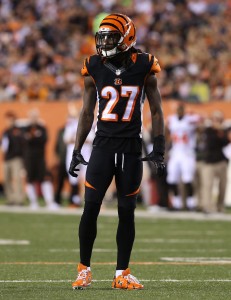
It’s easy to call the Kirkpatrick contract an overpay, as he’s never resembled a true No. 1 corner during his five-year NFL tenure. In 2016, Pro Football Focus graded Kirkpatrick as just the 52nd-best corner among 111 qualifiers, while he’s provided the 20th-most approximate value (Pro Football Reference’s catch-all metric) among cornerbacks since becoming a full-time starter in 2015. Despite that spotty record, Kirkpatrick’s new $10.5MM annual average ranks 11th among corners.
However, as with most Bengals contracts, the deal is more team-friendly than it initially appears. Kirkpatrick received only $12MM in full guarantees, which ranks 25th among cornerbacks, while his guarantee per year ($2.4MM) is only 24th among non-rookie corner accords. Conceivably, Cincinnati could remove itself from Kirkpatrick’s contract as soon as next spring — before he’s due a $3.25MM roster bonus — if he tanks during the 2017 campaign, and the dead money that would accelerate onto the Bengals’ cap following a release in either 2018 or 2019 isn’t ominous. Those scenarios are unlikely, of course, as most Cincinnati extendees play out their pacts.
While Kirkpatrick represented the majority of the Bengals’ free agent outlay, the club also made a value signing on defense with the addition of former Cardinals linebacker Kevin Minter. Only 26 years old, Minter played on at least 85% of Arizona’s defensive snaps in each of the past two seasons, and figures to slot in next to Vontaze Burfict in Cincinnati’s starting lineup. The Bengals made a smart contractual decision with Minter, using a $1.1MM workout bonus — which doesn’t count against the compensatory average per year formula — in order to lower his overall contract value. As Nick Korte of Over the Cap explained earlier this year (Twitter links), that strategy could end up bumping the Bengals’ projected seventh-round compensatory selection to a sixth-rounder, a marginal (but important) win.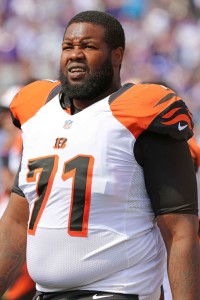
On the other side of the ball, Andre Smith is back in a Bengals uniform after a brief one-season layover in Minnesota. Smith, whom Cincinnati originally drafted sixth overall in 2009, won’t be lining up at his usual right tackle position, however, as the Bengals signed him to play guard. We’ll discuss Cincinnati’s offensive line issues a bit later, but the decision to bring in Smith is a risky one on two fronts. First, he’s never played guard in his NFL career, and second, he only managed to appear in four games in 2016 before going down with injury. The Bengals don’t have much high-quality interior depth, so relying on Smith as a starter at an all-new position seems perilous.
Elsewhere on offense, Cincinnati continued to opt for familiarity, re-signing wide receiver Brandon LaFell, running back Cedric Peerman, and offensive tackle Eric Winston to play reserve roles. LaFell, notably, led Bengals pass-catchers in snaps a season ago, but despite the fact that he’ll earn $5MM in 2017, his playtime percentage will almost certainly decrease. First-round rookie John Ross figures to start opposite A.J. Green with Tyler Boyd in the slot, meaning LaFell will be a well-paid fourth receiver at best.
Read more
Notable losses:
Andrew Whitworth and Kevin Zeitler‘s fates were seemingly sealed in 2015, when the Bengals used their first two draft picks on offensive lineman Cedric Ogbuehi and Jake Fisher. Cincinnati’s perspective on Whitworth and Zeitler’s free agency is clear: the club invested in linemen two years prior, and didn’t have any intention of spending exorbitant sums on a 35-year-old (Whitworth) or a guard (Zeitler). Still, given that the Bengals still have nearly $19MM in available cap space, it’s difficult to argue that Cincinnati shouldn’t have made more of an effort to retain at least one of its two best front five players.
Zeitler’s allowed defection is easier to understand, as the Bengals simply couldn’t compete financially with the division-rival Browns, who boasted enough cap room to make Zeitler the NFL’s highest-paid guard. Zeitler landed $12MM annually from Cleveland, a figure which makes him the top-earning right guard by $2MM. He also scored $23MM in full guarantees, $4MM more than runner-up T.J. Lang. Cincinnati should never have been expected to spend that much money on an interior player — fellow guard Clint Boling is earning just $5.2MM annually — so letting Zeitler go was defensible.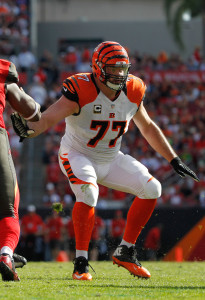
On the other hand, the Bengals should have put on the full-court press to retain Whitworth, who graded as Pro Football Focus‘ No. 2 offensive tackle and hasn’t shown any signs of decline even as he enters his 12th NFL season. Whitworth inked a three-year, $33.75MM pact with the Rams that contains $15MM guaranteed, but the deal isn’t all that it seems. The accord is effectively a two-year, $23MM contract, a more than manageable total for a top-flight left tackle. Re-signing Whitworth would have stabilized Cincinnati’s offensive line for a few more seasons, but the club will instead turn to Ogbuehi, who has never looked capable on an NFL field.
On defense, the Bengals parted ways with a couple of veterans who’d been with the team for a combined 19 seasons: defensive lineman Domata Peko and linebacker Rey Maualuga. Peko, 32, hasn’t been effective a number of years (PFF’s No. 106 DT in 2016), but he did reap a two-year contract from the Broncos. He’ll be replaced in Cincinnati by a combination of second-year player Andrew Billings and veteran Pat Sims. Maualuga, meanwhile, had seen his snap percentage dwindle in recent seasons (just 30% a season ago) and was released with one year left on his contract. He’s yet to find a new NFL home.
Rex Burkhead looked like the Bengals’ best running back at various points last season, especially during a Week 17 performance that saw him rush for 119 yards and two touchdowns on 27 carries. Among running backs with fewer than 99 rushes, Burkhead ranked first in both DYAR and DVOA, both of which are Football Outsiders efficiency metrics. He also played on nearly half of Cincinnati’s special teams snaps. Earning only $3.25MM on a one-year deal with New England, Burkhead’s absence will be felt.
Trades:
- Acquired DE Chris Smith from the Jaguars in exchange for a 2018 seventh-round pick.
- Acquired a 2017 second-round pick (No. 48; RB Joe Mixon) and a 2017 fourth-round pick (No. 128; WR Josh Malone) from the Vikings in exchange for a 2017 second-round pick (No. 41; RB Dalvin Cook).
- Acquired a 2017 sixth-round pick (No. 207; S Brandon Wilson) from the Titans in exchange for 2017 sixth-round pick (No. 217; OL Corey Levin) and a 2017 seventh-round pick (No. 227; LB Josh Carraway).
The Bengals had been eyeing defensive end Chris Smith for more than a year before acquiring him from the Jaguars, but he’s no lock to make the club’s roster. Cincinnati added two edge rushers in Jordan Willis and Carl Lawson during the draft, while Will Clarke and Wallace Gilberry will also compete for backup snaps at end. Smith hasn’t played much special teams during his three-year career, so his roster prospects could be limited despite the Bengals having forked over a draft pick for him. Cincinnati is currently projected to pick up a 2018 seventh-round compensatory pick, which would help alleviate the loss of the draft selection it gave up for Smith.
Given that Cincinnati was heavily linked to Joe Mixon prior to the draft, the team did well to pick up extra value before selecting the controversial Oklahoma running back later in the second round. By moving down only seven spots, the Bengals acquired 123 cents on the dollar from the Vikings, according to Chase Stuart of Football Perspective’s draft pick value calculator. Cincinnati’s second draft-day trade wasn’t as fruitful, as the club gave up 173 cents on the dollar to move up for defensive back Brandon Wilson.
Draft picks:
- 1-9: John Ross, WR (Washington)
- 2-48: Joe Mixon, RB (Oklahoma)
- 3-73: Jordan Willis, DE (Kansas State)
- 4-116: Carl Lawson, DE (Auburn)
- 4-128: Josh Malone, WR (Tennessee)
- 4-138: Ryan Glasgow, DT (Michigan)
- 5-153: Jake Elliott, K (Memphis)
- 5-176: J.J. Dielman, OL (Utah)
- 6-193: Jordan Evans, LB (Oklahoma)
- 6-207: Brandon Wilson, S (Houston)
- 7-251: Mason Schreck, TE (Buffalo)
As I noted on 700 WLW’s Sunday Morning Sports Talk (77:00 minute mark) last weekend, the Bengals seem to be addressing their offensive line limitations by adding speed at the skill positions. Both John Ross and Joe Mixon figure to contribute immediately, and it would be a surprise if both weren’t full-time starters midway through the season. Ross, specifically, should be able to help Cincinnati’s woeful front five, as safeties will have to play deep instead of near the line, alleviating the pressure on quarterback Andy Dalton. Josh Malone, meanwhile, is at least fifth on the Bengals’ wideout depth chart, and will start his NFL career on special teams duty.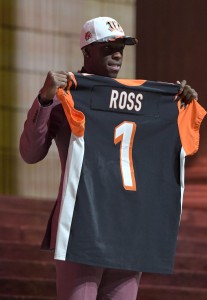
Finding edge rushing help was arguably Cincinnati’s No. 1 need heading into the offseason, and while the club didn’t do much in free agency to aid in that realm, the Bengals found two draft values in Jordan Willis and Carl Lawson, both of whom were viewed as potential Day 1 picks but fell until the third day of the draft. Lawson, in particular, has been working as an outside linebacker in Cincinnati’s 4-3 scheme, but he and Willis will likely see most of their action as sub package defensive ends, getting after opposing quarterbacks on passing downs.
Jake Elliott was surprisingly the first kicker off the board in the 2017 draft (most analysts rated Arizona State’s Zane Gonzalez as the top kicker), and given that the Bengals thought enough of him to invest a fifth-round pick, he’s overwhelmingly likely to act as the team’s kicker come Week 1. For now, he’ll compete in a nominal camp battle with veteran Randy Bullock and second-year kicker Jonathan Brown. Elliott converted 80.8% of his field goal attempts in 2016, but Lance Zierlein of NFL.com noted Elliott’s trouble with kickoff hang times.
Extensions and restructures:
Other:
Of the 32 first-round selections in the 2014 draft, only one choice — Philadelphia’s Marcus Smith — has provided fewer points of approximate value than Darqueze Dennard‘s four. Even when not limited by injuries, Dennard simply hasn’t been able to crack the Bengals’ starting lineup. In 2016, he played on only a third of the club’s defensive snaps. Ticketed for nickelback duties next season, Dennard will get the opportunity to prove he’s worth an ~$8.5MM salary in 2018. That figure is guaranteed for injury only, so Cincinnati can still escape the deal if Dennard doesn’t play well.
Top 10 cap charges for 2017:
- Andy Dalton, QB: $15,700,000
- A.J. Green, WR: $13,500,000
- Geno Atkins, DT: $10,600,000
- Dre Kirkpatrick, CB: $9,384,375
- Adam Jones, CB: $8,166,666
- Carlos Dunlap, DE: $7,250,000
- George Iloka, S: $5,400,000
- Michael Johnson, DE: $5,125,000
- Brandon LaFell, WR: $5,000,000
- Clint Boling, G: $4,925,000
The Bengals posted another typical Cincinnati offseason: a long-term commitment to at least one internal free agent, limited spending on external free agents, and a draft class that was lauded by most analysts. Whether the club’s moves will keep the Bengals in contention for another year is an open question, but Cincinnati should have a fighting chance even in a strong AFC North.
Information from Over the Cap and Roster Resource was used in the creation of this post. Photos courtesy of USA Today Sports Images.
By Connor J. Byrne |
at July 7, 2017 5:21 pm
Even though the Titans extended their playoff drought to eight years in 2016, the team made noticeable progress for the first time in a while. The Titans matched the Texans at 9-7, only finishing behind the AFC South champions because of a tiebreaker, and ranked a division-best 13th in the NFL in Football Outsiders’ DVOA metric. After his club nearly broke through last year, Titans general manager Jon Robinson spent the offseason making meaningful upgrades on both sides of the ball.
Notable signings:
- Logan Ryan, CB: Three years, $30MM. $12MM guaranteed.
- Sylvester Williams, DT: Three years, $16.5MM. $7.25MM guaranteed.
- Jonathan Cyprien, S: Four years, $25MM. $7MM guaranteed.
- Brynden Trawick, S: Two years, $4.75MM. $3MM guaranteed.
- Eric Decker, WR: One year, $4MM. $2.5MM guaranteed. $1.5MM available via incentives.
- Daren Bates, LB: Three years, $6MM. $1MM guaranteed.
- Karl Klug, DL: Two years, $5MM. $1MM guaranteed. $800K available via incentives.
- Phillip Supernaw, TE: Two years, $3MM. $600K guaranteed.
- Matt Cassel, QB: Two years, $5.25MM. $500K guaranteed.
- Nate Palmer, LB: Two years, $2.3MM. $350K guaranteed.
- Eric Weems, WR: Two years, $2.6MM. $275K guaranteed.
- Tim Lelito, OL: One year, $1MM. $100K guaranteed.
- Demontre Hurst, S: One year, $690K.
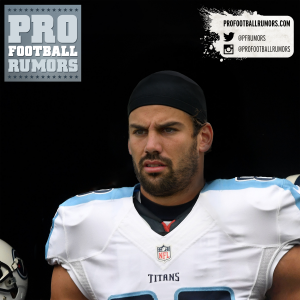
Robinson’s most recent splash came last month with the signing of wide receiver Eric Decker, who unexpectedly fell into the Titans’ laps after the rebuilding Jets released him. A shoulder injury limited Decker to three games last season and kept him out of the Jets’ lineup for the final three months of the campaign, but there’s no indication that it’ll hamper him going forward. That means a Tennessee offense which finished 2016 atop the league in red zone touchdown percentage should continue to be a force inside the opposition’s 20-yard line.
The 6-foot-3, 206-pound Decker has been a major threat near the goal line throughout his career, and he’s second only to ex-Jets teammate Brandon Marshall in red zone TD receptions since 2012 (33). The 30-year-old figures to mesh beautifully with Titans quarterback Marcus Mariota, who dominated in the red zone with 18 TD passes and no interceptions during his initial two years in the league.
When he signed with the Titans, Decker became the fourth potentially significant passing game weapon Robinson picked up for Mariota this offseason. The executive struck three times in the draft, using high selections on two wideouts – first-rounder Corey Davis and third-rounder Taywan Taylor – and another on tight end Jonnu Smith (Round 3). Of course, the headliner is Davis, who went fifth overall after surpassing 1,400 yards and 12 touchdowns in each of the past three seasons at Western Michigan. Interestingly, Lance Zierlein of NFL.com likens Davis to Decker, calling the 6-2, 205-pound rookie a “touchdown juggernaut.”
With Decker, Davis, Rishard Matthews and Taylor serving as the top four in their receiving corps and Smith joining the prolific Delanie Walker at tight end, Mariota has an enviable supply of aerial options on hand. Plus, the dual-threat signal-caller should again be a key contributor to a top-tier rushing attack. DeMarco Murray, Derrick Henry and Mariota ran behind arguably the NFL’s best offensive line and led a ground game that finished third in the league in rushing and fourth in yards per carry in 2016. Murray and Henry remain in the fold, as does the Titans’ starting O-line from last year, which is an unfortunate reality for opposing defenses.
Read more
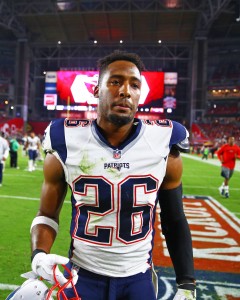
Speaking of defenses, the Titans’ Dick LeBeau-coordinated unit entered the winter in need of a makeover after ranking 20th in the league in yardage and 24th in DVOA. Robinson came through at the outset of free agency, reeling in two proven starters for his secondary in Jonathan Cyprien and Logan Ryan.
Cyprien spent the first four years of his career as a member of the division-rival Jaguars, with whom he started in all 60 appearances. He ranked as Pro Football Focus’ seventh-best safety last year, when he earned a near-flawless grade as a run defender.
Ryan, on the other hand, is a far bigger asset against the pass, and he’s coming off an excellent four-year showing in New England. As the Patriots’ former scouting director, Robinson was in their front office when they chose Ryan in the third round of the 2013 draft. Ryan, 26, is now a two-time Super Bowl champion who contributed heavily to New England’s defense with a combination of durability (64 straight appearances, including 40 starts) and productivity (13 interceptions).
Ryan and the Titans’ second first-rounder, 18th overall pick Adoree’ Jackson, are in line to helm a remade corner corps that also includes veteran Brice McCain, who started 10 games last year and rated as PFF’s 33rd-best CB. Jackson, like Ryan, is a ball hawk, having closed his USC career with five picks last season. Those two and McCain make for an impressive trio on paper, though it’s questionable whether the Titans have enough behind them. The pro track records of their other corners – Leshaun Sims, Kalan Reed, D’Joun Smith and Bennett Okotcha – range from nonexistent to extremely limited.
Considering Tennessee’s defense ended last year 26th in DVOA against the pass and 10th versus the run, it’s no surprise Robinson devoted most of his attention earlier this offseason to the secondary. But he didn’t ignore his team’s defensive line, where he signed nose tackle Sylvester Williams and re-upped role player Karl Klug early in free agency.
Despite starting 48 of 60 appearances in Denver 2013-16, Williams didn’t really live up to his first-round status in the Mile High City. With 5.5 career sacks, he won’t do a lot to aid the Titans’ pass rush (granted, after tallying the league’s fifth-most sacks and 12th-most hurries in 2016, it didn’t really need any), and it’s up for debate how much the 313-pounder will boost their run ‘D’. PFF assigned Williams a rather abysmal grade in that department last year, when 337 of his 644 snaps came in run situations. The outlet was much more bullish on Klug, whom it rated 22nd among 127 qualified interior defensive linemen (Williams was 46th). Klug has been valuable as defensive depth and on special teams since the Titans used a fifth-round pick on him in 2011, so it was likely a no-brainer for Robinson to bring him back for a meager $1MM in guaranteed money.
Notable losses:
- Antonio Andrews, RB
- David Bass, LB
- Byron Bell, OL
- Valentino Blake, CB
- Anthony Fasano, TE
- Rashad Johnson, S
- Marc Mariani, WR
- Jason McCourty, CB: Released
- Brian Schwenke, OL
- Sean Spence, LB
- Daimion Stafford, S
- Chance Warmack, G
- Al Woods, DT: Released
- Kendall Wright, WR
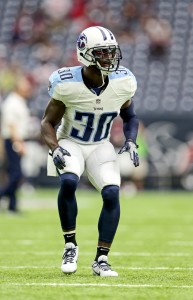
The Titans secured some potential high-impact players during free agency and the draft. At the same time, they didn’t say goodbye to any indispensable cogs. Jason McCourty stands out as the best of their departures. Prior to his release in April, the corner was the Titans’ longest-tenured player. McCourty had been with the team since it stole him in the sixth round of the 2009 draft, and he went on to start 90 games and pick off 13 passes in Tennessee. He accumulated 14 of those starts and two INTs last year, though PFF only regarded him as a middle-of-the-pack corner. The Titans, meanwhile, viewed him as too pricey. McCourty, now with the Browns, can still play, but he’s an obvious step down from Ryan at this juncture.
Unlike McCourty, others who exited the Titans’ roster in recent months didn’t come close to leaving indelible marks on the franchise. However, Sean Spence, Al Woods, Daimion Stafford, Rashad Johnson and Anthony Fasano did have semi-prominent roles with the club last year. The addition of Cyprien made Stafford and Johnson expendable, though, and the Titans immediately signed Williams to replace the released Woods. Meanwhile, Tennessee’s hope is that the blocking skills of Jonnu Smith and its offensive line will cover for Fasano’s exit.
Replacing Spence, who played half the Titans’ defensive snaps last year, could be a more difficult task. Now with the Colts, Spence was one of the most efficient tacklers in the league in 2016, according to PFF’s Michael Manning, who noted in May that the defender was also quite productive as a pass rusher. The Titans, to their credit, have a quality starting inside linebacker tandem with Avery Williamson and Wesley Woodyard. But going from Spence to the re-signed Nate Palmer as the top reserve in the middle looks like a downgrade.
Trades:
- Acquired a 2017 third-round pick (No. 72; WR Taywan Taylor) and a 2017 sixth-round pick (No. 200) from the Patriots in exchange for a 2017 third-round pick (No. 83; DE Derek Rivers) and a 2017 fourth-round pick (No. 124).
- Acquired a 2017 sixth-round pick (No. 207) and a 2017 seventh-round pick (No. 241; RB Khalfani Muhammad) from the Giants in exchange for a 2017 sixth-round pick (No. 200; T Adam Bisnowaty).
- Acquired a 2017 sixth-round pick (No. 217; OL Corey Levin) and a 2017 seventh-round pick (No. 227; LB Josh Carraway) from the Bengals in exchange for a 2017 sixth-round pick (No. 207; S Brandon Wilson).
Draft picks:
Extensions and restructures:
A former Bronco, Woodyard joined the Titans after the 2013 season and did enough over his first three years with the organization to earn a reasonably priced extension. The 31-year-old Woodyard, who’s now under Tennessee’s control through 2019, has appeared in 48 games in a row as a Titan. Thirty-eight of those contests have been starts, including 10 last season, when Woodyard graded as PFF’s 29th-best linebacker. Overall, Woodyard has collected 10 sacks and three INTs in Tennessee.
Other:
Picking up Lewan’s fifth-year option was an easy call for Robinson, who was one of the premier acquisitions of previous GM Ruston Webster’s tenure. Lewan, whom Webster took 11th overall in 2014, is coming off his first 16-start season, in which the left tackle earned a Pro Bowl nod. He’ll be a Titan through at least 2018, meaning they’ll have the elite-caliber offensive tackle duo of Lewan and Jack Conklin for a minimum of two more seasons.
Top 10 cap charges for 2017:
- Brian Orakpo, LB: $9,450,000
- Logan Ryan, CB: $8,666,666
- Jurrell Casey, DT: $8,588,750
- Derrick Morgan, LB: $7,968,750
- DeMarco Murray, RB: $6,950,000
- Marcus Mariota, QB: $6,603,811
- Rishard Matthews, WR: $6,333,333
- Delanie Walker, TE: $5,317,708
- Jonathan Cyprien, S: $4,750,000
- Sylvester Williams, DT: $4,666,666
Robinson has done laudable work during his two offseasons as Tennessee’s GM, and the moves he made this past winter and spring just might propel the team back to the playoffs. It appears the Mike Mularkey-coached Titans will enter the season with the strongest roster in a division that’s there for the taking.
Information from Over the Cap and Roster Resource was used in the creation of this post. Photos courtesy of USA Today Sports Images.
By Zachary Links |
at July 7, 2017 2:25 pm
Last year, things didn’t exactly go according to plan for the Cardinals as they finished out 7-8-1, missing the playoffs for the first time since 2013. With little salary cap room to work with, it’s not exactly clear if the Cardinals have put themselves in position for a big turnaround.
Notable signings:
- Chandler Jones, LB: Five years, $82.5MM. $21MM guaranteed. Had been assigned franchise tag.
- Jermaine Gresham, TE: Four years, $28MM. $13MM guaranteed.
- Antoine Bethea, S: Three years, $12.75MM. $2MM guaranteed.
- Phil Dawson, K: Two years, $6MM. $1.5MM guaranteed.
- Jarvis Jones, LB: One year, $2.25MM. $1MM guaranteed.
- Karlos Dansby, LB: One year, $2MM. $750K guaranteed.
- A.Q. Shipley, C: Two years, $3.5MM. $725K guaranteed.
- Frostee Rucker, DL: One year, $1.08MM. $80K guaranteed.
- Andre Ellington, RB: One year, $905K. $80K guaranteed.
- Tony Bergstrom, C: One year, minimum salary benefit.
- Blaine Gabbert, QB: One year, minimum salary benefit.
- Jeremy Ross, WR: One year, minimum salary benefit.
- Aaron Dobson, WR: One year, $615K.
- Jumal Rolle, CB: One year, $615K.
The Cardinals knew they’d have to pony up a massive deal when they acquired Chandler Jones via trade from the Patriots. This year, they applied the franchise tag to Jones but the two sides shook hands on a massive extension just days later. Jones’ new deal makes him the third-highest paid 3-4 outside linebacker in the NFL, trailing only Von Miller and Justin Houston in terms of yearly average. When it comes to average guarantees per year, he’s in second place with $6.2MM, ahead of Houston. It wasn’t cheap to lock up Jones, but he is one of the league’s very best edge defenders and the market is only growing for those players. If Jones continues on this trajectory, it will all be worth it for Arizona. 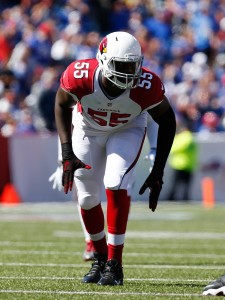
Considering the Cardinals’ cap situation, their four-year, $28MM deal for tight end Jermaine Gresham was a bit perplexing. Before the free agent market officially opened, I had Gresham ranked as the ninth-best option available. The 28-year-old (29 in June) had 37 catches for 391 yards last year, but he doesn’t offer much in the way of blocking. The good news is that the 29-year-old will only carry a $3.75MM cap number in 2017, but his contract doesn’t look so great after that. In 2018, the Cardinals are saddled with a $7.25MM cap number and releasing him ($9.25MM) isn’t really a viable option. In 2019, they’ll be stuck with $3.5MM if they release Gresham.
Free agent addition Antoine Bethea projects as the Cardinals’ starting strong safety, but he may have to duke it out with the team’s second round pick (more on him later). The soon-to-be 33-year-old did well for himself on this deal and the Cardinals are hoping that he will continue to be an above-average playmaker in the secondary. Bethea has started all 162 games he’s played since entering the league and he has 19 career interceptions to his name.
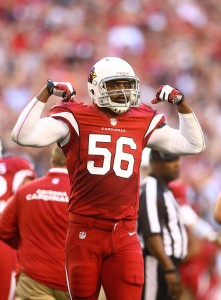 The Cardinals added two notable free agents to the linebacking group in Karlos Dansby and Jarvis Jones. Dansby returns to the Cardinals after spending the first six years of his career with them, plus the 2013 season. Dansby night not be a top 15 type like he was in 2013 and 2014, but he’s still quite productive even at his advanced age. The linebacker, 36 in November, had upwards of 100 tackles last year and finished out as Pro Football Focus’ 46th best linebacker out of 87 qualified players.
The Cardinals added two notable free agents to the linebacking group in Karlos Dansby and Jarvis Jones. Dansby returns to the Cardinals after spending the first six years of his career with them, plus the 2013 season. Dansby night not be a top 15 type like he was in 2013 and 2014, but he’s still quite productive even at his advanced age. The linebacker, 36 in November, had upwards of 100 tackles last year and finished out as Pro Football Focus’ 46th best linebacker out of 87 qualified players.
Jones, a former first round pick, has only posted six sacks in four NFL seasons. He recorded a career-high 43 tackles in 2016, however, and started nine games for the Steelers. He has not lived up to his draft status, but he is still a solid run defender and he could still have some untapped potential. With talented veterans in front of him, the Cardinals will only be using Jones on a limited basis, a role that might suit him well.
Not long ago, Andre Ellington was the main rusher in Arizona. Now, the emergence of David Johnson has pushed him down the pecking order. The Cardinals were exploring the idea of moving Ellington to wide receiver this year, but they abandoned that midway through the offseason. It’s still a good bet that Ellington will make the 53-man cut as a reserve behind Johnson.
Read more
Notable losses:
- Taylor Boggs, OL
- Calais Campbell, DE
- Chandler Catanzaro, K
- Marcus Cooper, CB
- Zac Dysert, QB: Waived
- Darren Fells, TE
- Tony Jefferson, S
- Mike Jenkins, CB
- Chris Johnson, RB
- Evan Mathis, G: Retired
- Kevin Minter, LB
- Sio Moore, LB
- Alex Okafor, DE
- D.J. Swearinger, S
- Stepfan Taylor, RB
- Daryl Washington, LB: Released
- Earl Watford, G
The Cardinals worked to keep Tony Jefferson before the start of free agency but they couldn’t come up with enough cash to keep him from exploring free agency. Reportedly, Arizona’s final offer to Jefferson was a four-year, $24MM deal. He wound up signing with the Ravens on a four-year, $37MM deal and even that reportedly wasn’t his highest offer. The Cardinals sensed early on that they wouldn’t be able to retain Jefferson and his market only improved when Eric Berry re-upped with the Chiefs. After a season in which he placed as PFF’s fifth-best safety, he’ll be missed in Arizona.
When the Cardinals acquired Jones from New England, Calais Campbell became something of an afterthought. Perhaps motivated by a perceived slight, Campbell turned in his best season to date. The Cardinals were probably expecting to move on from Campbell this offseason, but his performance made his departure a bitter pill to swallow. The University of Miami product got $60MM over four years with $30MM guaranteed from the Jaguars – numbers that Arizona couldn’t come close to matching. The Cardinals were able to cobble together a nice Plan B after Jefferson left, but they are looking a little shaky on the defensive line now that Campbell is gone. Frostee Rucker, Corey Peters, and rising sophomore Robert Nkemdiche project as the starters. It’s a capable group, but that unit is far from a sure thing. 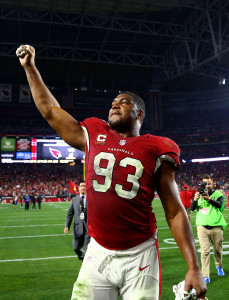
Out of nowhere, linebacker Daryl Washington was finally reinstated by the league office this spring. The move left the Cardinals with a decision to make on his $2.9MM salary. After early word that the Cardinals would definitely dump him, it appears that the team did actually want him around – just at a lesser pay grade. Ultimately, the two sides could not come to terms on a deal and Washington is still seeking employment. The one-time standout has not been on the field since 2013.
The Cardinals made an under-the-radar smart trade prior to last season, sending a 2018 seventh-round pick to Kansas City for cornerback Marcus Cooper. Cooper wound up making 13 starts for the Cardinals and turning himself into a sought-after cornerback on the market this spring. Cooper was another victim of the Cards’ cap crunch and there wasn’t a great effort made to retain him. He landed a three-year, $16MM deal with the Bears.
Trades:
- Acquired a 2017 second-round pick (No. 36; S Budda Baker) and a 2017 seventh-round pick (No. 221) from the Bears in exchange for acquired a 2017 second-round pick (No. 45; TE Adam Shaheen), a 2017 fourth-round pick (No. 119; RB Tarik Cohen), a 2017 sixth-round pick (No. 197), and a 2018 fourth-round pick.
- Acquired a 2017 third-round pick (No. 98; WR Chad Williams) and a 2017 fourth-round pick (No. 115; OL Dorian Johnson) from the Panthers in exchange for a 2017 third-round pick (No. 77; DE Daeshon Hall).
- Acquired a 2017 sixth-round pick (No. 208; S Johnathan Ford) from the Raiders in exchange for a 2017 seventh-round pick (No. 221; DB Shalom Luani) and a 2017 seventh-round pick (No. 231; T Jylan Ware).
Draft picks:
The Cardinals lost some big names this year and they didn’t have a lot of dollars to spend on the open market to compensate. If the Cardinals are to get back to contention this season, they’ll need their rookies to quickly get comfortable with the pace of the NFL. 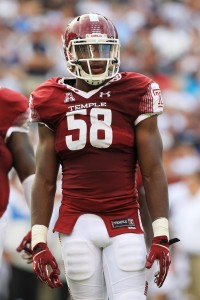
The buzz around Haason Reddick became deafening in the months leading up to the draft. Reddick came to Temple as a preferred walk-on and, at one time, he was almost pushed out of the program. Towards the end of his time in Philadelphia, the light turned on for Reddick and he solidified himself as one of the best linebackers in the 2017 class. In the long run, Reddick may be used as an edge rusher if he can bulk up. For right now, it looks like he’ll start the year at inside linebacker as Deone Bucannon recovers from ankle surgery. When Bucannon is back, Reddick figures to be a big part of the team’s plans, even if he is in the role of supersub.
Aside from Reddick, no rookie will be more central to Arizona’s plans than Budda Baker. The Washington product may start the year as Bethea’s backup, but they could wind up switching spots during the season. Baker has a high football IQ for such a young player and his aggressive playing style could trump the vast experience of Bethea at some point.
Extensions and restructures:
Other:
Top 10 cap charges for 2017:
- Carson Palmer, QB: $24,125,000
- Larry Fitzgerald, WR: $15,850,000
- Patrick Peterson, CB: $13,706,965
- Chandler Jones, LB: $10,000,000
- Jared Veldheer, T: $10,000,000
- Mike Iupati, G: $9,700,000
- Tyrann Mathieu, S: $8,100,000
- Drew Stanton, QB: $4,150,000
- Jermaine Gresham, TE: $3,750,000
- Corey Peters, DT: $3,660,418
The Cardinals are still the NFC West team best equipped to challenge the Seahawks for the divisional crown, but it could be a challenge after losing two big stars on defense. Of course, injuries were a big issue for the Cards in 2016 and staying healthy will go a long way towards putting Arizona back in the playoff mix.
Information from Over the Cap and Roster Resource was used in the creation of this post. Photos courtesy of USA Today Sports Images.
By Zachary Links |
at July 6, 2017 2:40 pm
You only get to make one first impression and the Rams’ Los Angeles debut was less than impressive. The Rams got uneven performances out of rookie quarterback Jared Goff (to put it mildly), finished 4-12, and wound up sacking coach Jeff Fisher before the season was through. Now, the Rams are sharing the L.A. market with another team and they hope to set themselves apart with a better showing in 2017.
Notable signings:
- Trumaine Johnson, CB: One year, $16.742MM. Fully guaranteed. Signed franchise tag.
- Andrew Whitworth, T: Three years, $33.75MM. $15MM guaranteed.
- Robert Woods, WR: Five years, $34MM. $10MM guaranteed.
- Kayvon Webster, CB: Two years, $8MM. $4.25MM guaranteed. $4MM available via incentives.
- Greg Zuerlein, K: Three years, $6.75MM. $2.375MM guaranteed.
- Lance Dunbar, RB: One year, $1.5MM. $1.375MM guaranteed. $1.5MM available via incentives.
- John Sullivan, C: One year, $1MM. $100K guaranteed.
- Nickell Robey-Coleman, CB: One year, minimum salary benefit. $80K guaranteed.
- Connor Barwin, LB: One year, $3.5MM. $3MM available via incentives.
- Dominique Easley, DT: One year, $1.797MM. Signed original round RFA tender.
- Ethan Westbrooks, DE: One year, $1.797MM. Signed original round RFA tender.
Last year, the Rams had two standout cornerbacks set to hit the open market and only one franchise tag to use. They opted to retain Trumaine Johnson while allowing Janoris Jenkins to test free agency. The Rams were apparently close to keeping Jenkins, but he ultimately left to sign a big money deal with the Giants. After watching the 2016 season play out, the decision to roll with Johnson over Jenkins doesn’t look so great. Determined to not lose a star cornerback two years in a row, the Rams used the tag on Johnson for the second year in a row, resulting in a hefty one-year, $16.742MM tender. 
Now, the two sides have until July 17th (not July 15th) to hammer out an extension. Unfortunately, it doesn’t sound like we will see a new deal struck in the coming days. Unless things change, Johnson will play out the year with the highest yearly salary of any cornerback in the NFL. Johnson graded out as Pro Football Focus’ 26th-best cornerback last season, indicating that he is starting caliber, but far from elite. Los Angeles would like to tamp down that bloated cap number and lock Johnson up through his prime years, but he seems willing to bet on himself.
The Rams landed this year’s most talented free agent tackle when they signed veteran Andrew Whitworth. A three-year deal with strong cash flow in the first two years may not seem ideal for a 35-year-old, but that’s the cost of doing business when trying to add top offensive tackles. In 2016, PFF rated him as the second-best tackle in the entire NFL and he’s been a Top 5/Top 10 guy for the last five years in a row. The Rams are hoping that the addition of Whitworth will help to give Goff extra time in the pocket, allowing him to make better throws when he’s not under duress. Last year, the Rams finished out with the sixth-worst offensive line in the NFL, according to PFF’s metrics.
Goff will have some new mouths to feed this year, including free agent Robert Woods. Woods made a name for himself in Buffalo as a solid stand-in for Sammy Watkins when he dealt with injury. Now, he’s being counted upon as the WR1 in Los Angeles. Even though he signed a five-year deal, it should be noted that he won’t be long for Los Angeles if he can’t handle his new responsibilities. Woods is due $5MM on the third day of the 2018 league year and nothing is guaranteed for the former Bills complementary target past Year 2.
Read more
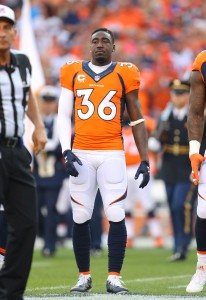 Kayvon Webster was blocked by corners Chris Harris, Aqib Talib and Bradley Roby and safeties Justin Simmons and Will Parks in Denver. He was vocal about wanting playing time in 2017 and he’ll get his shot with the Rams. Wade Phillips imported Webster to serve as a starting CB opposite Johnson and we’ll soon find out whether he’s top 60 at the position or simply a talented special teams guy.
Kayvon Webster was blocked by corners Chris Harris, Aqib Talib and Bradley Roby and safeties Justin Simmons and Will Parks in Denver. He was vocal about wanting playing time in 2017 and he’ll get his shot with the Rams. Wade Phillips imported Webster to serve as a starting CB opposite Johnson and we’ll soon find out whether he’s top 60 at the position or simply a talented special teams guy.
The Rams may have found two of the offseason’s best values by signing Connor Barwin (one-year, $3.5MM deal) and slot specialist Nickell Robey-Coleman (one-year, minimum salary deal). Barwin played for Phillips with the Texans from 2011-12, and the 30-year-old chose L.A. in part because of the lovable defensive coordinator.
“Wade did a lot for me in the two years I was with Houston,” said Barwin. “He taught me so much about being a pro, enjoying being around the game every single day, and he really elevated my game as a pass rusher.”
Barwin now joins a talented linebacker group which includes Robert Quinn, Alec Ogletree, and Mark Barron. Coupled with the great potential of the defensive line, Phillips has one heck of a front seven to work with.
Robey-Coleman’s release from the Bills was a surprised rivaled only by the low price tag on his deal with the Rams. Last year, the corner earned a higher grade from PFF than former Buffalo teammates
Stephon Gilmore and
Ronald Darby. It would be a surprise if he bested both of them again in 2017, but there’s no question that there is great potential for Robey-Coleman to outperform his contract.
Notable losses:
- Tim Barnes, C: Released
- Kenny Britt, WR
- Benny Cunningham, RB
- Case Keenum, QB
- Lance Kendricks, TE: Released
- T.J. McDonald, S
- Brian Quick, WR
- Chase Reynolds, RB
- Demetrius Rhaney, C: Waived
- Eugene Sims, DE: Released
- Cam Thomas, DT
This offseason, the Rams said adios to Kenny Britt. The highly talented Rutgers product was never able to put it all together at the NFL level until last year when he had managed to turn in his first career 1,000+ yard campaign, despite playing in the league’s worst offense. Britt’s work ethic frequently came into question during his college days and it’s possible that the Rams had questions about his maturity when it came time to pay him. It’s also possible that they just saw a four-year deal worth $32.5MM with $17MM guaranteed (the deal he got from the Browns) as too rich of a price tag. Ultimately, they’re betting on better production out of Woods than Britt and you won’t find many talent evaluators willing to support that choice. The Rams will also forge ahead without Brian Quick, who projects to be the WR4 in Washington. 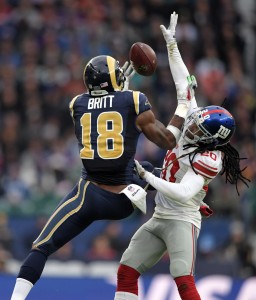
A couple other familiar faces are gone on the offensive side. The Rams’ old regime had high hopes for Lance Kendricks, signing him to a four-year, $18.5MM pact some time ago. The new regime wasn’t as crazy about him. The Rams got out of the deal two years early, even though he had a career-high 50 receptions last year for 499 yards and two scores. There’s now a youth movement going down at tight end, something that we’ll explore a little further down the page.
In two years with St. Louis/Los Angeles, Keenum appeared in ten games with nine starts. The results were less than spectacular and it didn’t seem like the team made much of an attempt to retain him. Now that he’s gone, Sean Mannion will be the primary backup for Goff.
McDonald was the Rams’ starting safety since entering the league in 2013 all the way through 2016. This spring, however, the Rams made no attempt to retain him. The safety is facing an eight-game suspension for violating the league’s substance abuse policy, but that will be a headache for another team (the Dolphins) in 2017.
Sims, 31, appeared in all 16 games for the Rams last season and made eight starts. The advanced numbers at PFF have never been high on Sims and neither was Phillips, apparently. Sims was dropped during a major player purge around the start of free agency and we haven’t heard any word of teams being interested in him in the last four months. That’s a sign that Sims is still not healthy enough to play (he was cut with a failed physical designation) or that teams no longer see him as a quality defensive end.
Trades:
- Acquired a 2017 sixth-round pick (No. 206) from the Dolphins in exchange for DE William Hayes and a 2017 seventh-round pick (No. 223).
- Acquired a 2017 second-round pick (No. 44; TE Gerald Everett) and a 2017 third-round pick (No. 91; S John Johnson) from the Bills in exchange for a 2017 second-round pick (No. 37; WR Zay Jones) and a 2017 fifth-round pick (No. 149).
- Acquired a 2017 fourth-round pick (No. 117; WR Josh Reynolds) and a 2017 sixth-round pick (No. 197) from the Bears in exchange for a 2017 fourth-round pick (No. 112; S Eddie Jackson).
- Acquired a 2017 fourth-round pick (No. 125; LB Samson Ebukam) from the Jets in exchange for a 2017 fourth-round pick (No. 141; WR Chad Hansen) and a 2017 sixth-round pick (No. 197; CB Jeremy Clark).
- Acquired a 2018 sixth-round pick from the Lions in exchange for T Greg Robinson.
It’s hard to find fault with the William Hayes deal from the Dolphins’ perspective. From the Rams’ side, however, the deal is a bit perplexing. Hayes had two years to go on his three-year, $17.5MM contract, a good value considering the way that lesser pass rushers have gotten paid since then. It seems that Phillips didn’t like his chances of transitioning from a 4-3 to a 3-4 defense. If Hayes (and McDonald, for that matter) breaks out in Miami, there will be a lot of second guessing going on in L.A. On a related note, Hayes’ deal was shortened to allow him to reach the free agent market after the 2017 season.
The Rams moved back in the second round and got themselves a new starting tight end seven spots down. Gerald Everett will now take the place of Kendricks in the offense and the Rams are hoping for better results. Interestingly, the Rams’ failsafe for Everett is also a relative youngster. Tyler Higbee, who slid down draft boards in 2016 thanks to his off-field behavior, is expected to see significant snaps behind the rookie. Beyond them, there’s Cory Harkey – a relatively unknown holdover from the old regime – and 2016 sixth-round choice Temarrick Hemingway. If the Rams don’t like what they see from the TE group in August, don’t be surprised if they look at external options.
Rams fans were tired of waiting for Greg Robinson to do something at the professional level and so were the Rams. When Taylor Decker went down with an injury, the Rams pawned the former No. 2 overall pick off on the Lions in exchange for a sixth-round choice. Maybe a change of scenery will do Robinson good, but it was abundantly clear that things were just not going to work for him with the Rams. In each of the last three seasons, the advanced numbers have pegged Robinson as one of the league’s worst tackles.
Draft picks:
The Rams did not have a first-round choice in this year’s draft thanks to the Jared Goff trade of 2016. After this year, we might have a better handle on whether that was a smart trade for L.A.
Other:
This offseason, the Rams made Sean McVay the youngest coach in the NFL’s modern era. He might not have as much experience as other candidates, but his fresh perspective is exciting to GM Les Snead.
“Exciting, because you see the young head coach but you also see him bring this unbelievable energy and passion to the job with that thought of how he wants to put together his staff and the puzzle there and what he’s trying to accomplish,” the GM said. “You’re working together to problem-solve, come up with solutions, come up with decisions and try to come up with what’s best for the Rams…. You can feel the chemistry developing based on just rolling up your sleeves and going to work and making your first decisions together.”
The former Redskins offensive coordinator has developed a reputation as a quarterback whisperer after helping to turn Kirk Cousins into a top signal caller. Goff was inconsistent under center last year and the Rams are hoping that McVay will be able to get him on the right track. Ultimately, the fates of the young quarterback and the young coach may be tied together.
McVay is not daunted by the challenge of being a 31-year-old head coach and he’ll even be calling the plays on offense. On the other side of the ball, veteran defensive coordinator Wade Phillips is calling the shots. The Broncos effectively let Phillips skip town this offseason and the Rams were thrilled to give him a new home.
Top 10 cap charges for 2017:
- Trumaine Johnson, CB: $16,742,400
- Tavon Austin, WR: $14,977,116
- Mark Barron, LB: $11,000,000
- Michael Brockers, DT: $11,000,000
- Robert Quinn, LB $10,750,334
- Andrew Whitworth, T: $9,166,666
- Alec Ogletree, LB: $8,369,000
- Robert Woods, WR: $7,000,000
- Jared Goff, QB: $6,349,471
- Rodger Saffold, G: $6,190,983
The worst contract in this bunch probably belongs to Tavon Austin, and he inked his extension less than one year ago. Austin, 26, hasn’t done a whole lot to justify being taken No. 8 overall in 2013. Now, he has a deal that averages $10.5MM through the 2021 season. Last year, Austin set a career high with 58 catches, but he averaged only 8.8 yards per grab. Next year, the Rams can drop Austin if they’re willing to take on $5MM in dead money while saving $3MM against the cap. If he can’t take a step forward, don’t be surprised if McVay & Co. cut ties.
Information from Over the Cap and Roster Resource was used in the creation of this post. Photos courtesy of USA Today Sports Images.
By Ben Levine |
at September 12, 2016 10:00 pm
The Rams had the top pick in this past year’s draft. They added a number of veteran defensive free agents. They signed their top wideout to a lucrative extension.
Still, despite all of these headlines, the biggest “move” by the Rams was their relocation to Los Angeles. After 20 years (and a Super Bowl championship) in St. Louis, the organization is returning to the City of Angels.
Following a 2015 season that featured a 7-9 record and plenty of promise from Offensive Rookie of the Year Todd Gurley, the assumption would be that the team would take another step forward in 2016. The Rams will undoubtedly be in a bigger spotlight, but did the front office do enough to bring a contender to Los Angeles?
Notable signings:
- Mark Barron, LB: Five years, $45MM. $15MM guaranteed.
- Trumaine Johnson, CB: One year, $13,952MM. Fully guaranteed. Accepted franchise tag.
- William Hayes, DE: Three years, $17.5MM. $10MM guaranteed.
- Coty Sensabaugh, CB: Three years, $14.5MM. $5.5MM guaranteed.
- Tim Barnes, C: Two years, $5.5MM. $3.25MM guaranteed.
- Eugene Sims, DE: Three years, $10MM. $3MM guaranteed.
- Cory Harkey, TE: Three years, $5.7MM. $2.5MM guaranteed.
- Brian Quick, WR: One year, $1.75MM. $1.5MM guaranteed.
- Cody Davis, S: Two years, $2,916,666. $805K guaranteed.
- Greg Zuerlein, K: One year, $1.25MM. $675K guaranteed.
- Chase Reynolds, RB: One year, $875K. $200K guaranteed.
- Case Keenum, QB: One year, $3.635MM. Signed first-round RFA tender.
- Benny Cunningham, RB: One year, $1.671MM. Signed original-round RFA tender.
- Cam Thomas, DT: One year, minimum salary benefit.
- Dominique Easley, DT: One year, $600K.
The Rams were clearly encouraged by their step forward in 2015, so the front office spent their offseason re-signing many of their key free agents.
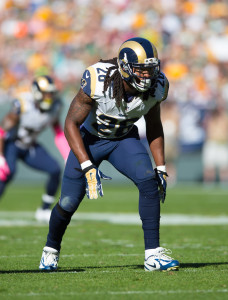 Mark Barron, a former first-round pick, may be the most notable signing. After having revived his career in St. Louis last season, the 26-year-old inked a five-year contract to remain with the organization. Barron set career-highs in tackles (76) and forced fumbles (three) in 2015, and he’ll presumably remain as the team’s starting outside linebacker, providing some experience to a youthful unit.
Mark Barron, a former first-round pick, may be the most notable signing. After having revived his career in St. Louis last season, the 26-year-old inked a five-year contract to remain with the organization. Barron set career-highs in tackles (76) and forced fumbles (three) in 2015, and he’ll presumably remain as the team’s starting outside linebacker, providing some experience to a youthful unit.
Cornerback Trumaine Johnson will also remain with the team. The 26-year-old ultimately accepted his franchise tender, keeping him in Los Angeles for at least one more season. The starting cornerback had his most productive season in 2015, establishing career-highs in tackles (58), interceptions (seven), and passes defended (17). The defensive back will be joined by Coty Sensabaugh, who joined the Rams this offseason following four seasons with the Titans. The 27-year-old started 15 games last season, compiling 42 tackles and a pair of interceptions.
Elsewhere on defense, defensive lineman William Hayes will be sticking around for three more seasons. The 31-year-old has split his eight-year career between the Titans and Rams, and the veteran finished with at least four sacks in each of his four seasons in St. Louis. Veteran lineman Eugene Sims will also be returning to the organization, and the front office brought in a former first-rounder in lineman Dominique Easley to round out the defensive line.
On the other side of the ball, the team’s big re-signing was center Tim Barnes, who has appeared in 61 of a possible 64 games since going undrafted in 2012. The 28-year-old 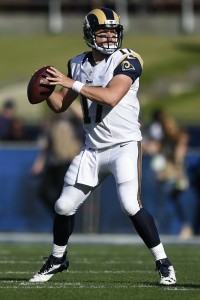 should be the veteran leader of the Rams’ offensive line, as the other four starters are all 24-years-old or younger.
should be the veteran leader of the Rams’ offensive line, as the other four starters are all 24-years-old or younger.
Barnes will be blocking for quarterback Case Keenum, who signed his restricted free agent tender with the squad. The 28-year-old has 15 career starts through four NFL seasons, and the coaching staff felt comfortable making the journeyman their starter, even over first-overall pick Jared Goff. In five games last season, Keenum completed 61-percent of his passes for 828 yards, four scores, and one interception.
The organization held on to wideout Brian Quick, who has yet to breakout after being selected in the second round of the 2012 draft. The 27-year-old had his least productive season in 2015, hauling in only 10 catches for 102 yards. The Rams also retained a pair of running backs in Benny Cunningham and Chase Reynolds.
Continue reading about the Rams’ offseason…
Read more
Notable losses:
- Akeem Ayers, LB: Released
- Daren Bates, LB
- Jared Cook, TE: Released
- Nick Fairley, DT
- Nick Foles, QB: Released
- Janoris Jenkins, CB
- James Laurinaitis, LB: Released
- Chris Long, DE: Released
- Rodney McLeod, S
- Wes Welker, WR
While the Rams did an admirable job of retaining many of their defense free agents, they also cut bait with a number of notable veterans. Former second-overall pick Chris Long was perhaps the most notable release, as the 31-year-old had spent the previous eight seasons with the organization. Long, who ultimately landed with the Patriots, has started only 11 games over the past two seasons, but his veteran leadership could have benefited a young defensive line.
Akeem Ayers‘ tenure with the franchise also came to an end after only one season. Following a breakout second-half of the 2014 season, Ayers was expected to play a significant role on the Rams defense. Instead, the 27-year-old ended up starting only 12 games while compiling underwhelming statistics. Veteran linebacker James Laurinaitis was also released by the Rams following seven seasons with the team. The former Ohio State star has started 16 games in each of his seven NFL seasons, although his tackles and sacks count did drop a bit in 2015.
Defensive backs Janoris Jenkins and Rodney McLeod were both starters on last year’s Rams squad, but the duo ended up getting lucrative contracts from the Giants and Eagles, respectively. Having combined for four interceptions and 20 passes defended, the team is 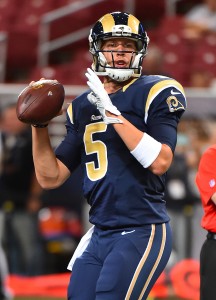 looking to replace their production with E.J. Gaines, T.J. McDonald, and Cody Davis.
looking to replace their production with E.J. Gaines, T.J. McDonald, and Cody Davis.
The team lost a trio of veterans on the offensive side of the ball. Quarterback Nick Foles was let go following one season with the Rams. The former Pro Bowler was disappointing in his 11 starts, completing only 56-percent of his passes while throwing seven touchdowns and 10 interceptions. Veteran tight end Jared Cook was also released after having spent several seasons with the organization. The 29-year-old (who ultimately landed on the Packers) was productive throughout his tenure in St. Louis, averaging 47 receptions, 595 yards, and nearly three touchdowns a season. Finally, veteran wideout Wes Welker struggled to stay on the field, but he still managed to collect 12 receptions in 2015.
Trades:
- Acquired a 2016 first-round pick (No. 1), a 2016 fourth-round pick (No. 113), and a 2016 sixth-round pick (No. 177) from the Titans in exchange for a 2016 first-round pick (No. 15), two 2016 second-round picks (Nos. 43 and 45), a 2016 third-round pick (No. 76), a 2017 first-round pick, and a 2017 third-round pick.
- Rams will also acquire a 2017 seventh-round pick if they send their own 2017 third-rounder to the Titans, rather than a third-round comp pick.
- Acquired a 2016 fourth-round pick (No. 117) and a 2016 sixth-round pick (No. 206) from the Bears in exchange for a 2016 fourth-round pick (No. 113).
The Rams’ biggest move of the offseason was the acquisition of the top-overall pick in this year’s draft. We’ll analyze the actual picks below, but let’s see how the Rams actually fared in their trades (using the classic, Jimmy Johnson Draft Trade Chart):
Rams acquired 3,088.6 points worth of value:
- No. 1 pick (3,000 points)
- No. 113 pick (68 points)
- No. 177 pick (20.6 points)
Rams gave up at least 2,886 points worth of value:
- No. 15 pick (1,050 points)
- No. 43 pick (470 points)
- No. 45 pick (450 points)
- No. 76 pick (210 points)
- 2017 first (at least 590 points)
- 2017 third (at least 116 points)
While it would seem like the Rams gave up an absolute haul for the first-overall pick, the trade chart indicates that the front office may have made off with a minor steal. Of course, the team traded for (what they believe to be) a franchise quarterback, and you can’t necessarily determine that value from a chart.
Draft picks:
With that top overall pick in the draft, the Rams selected California quarterback Jared Goff. While the 21-year-old may be sitting third on the QB depth chart for the start of the season, 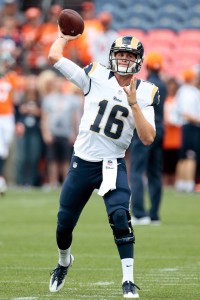 there’s no denying that the California-native is the future of the franchise. Goff has been praised for his arm strength, size, mobility, and his on-field attitude, although some have questioned his decision making.
there’s no denying that the California-native is the future of the franchise. Goff has been praised for his arm strength, size, mobility, and his on-field attitude, although some have questioned his decision making.
Of course, the rookie will begin to limit those mistakes as he gets more experience in the NFL. Goff certainly showed that he belonged in the league during his junior season at Cal, where he completed 64% of his passes for 4,714 yards, 43 touchdowns, and only 13 interceptions. There’s no denying that production (especially in a division as competitive as the Pac-12), so fans shouldn’t be pessimistic about Goff’s current spot on the depth chart.
After having dealt off a wealth of picks to acquire the quarterback, the Rams didn’t select again until the fourth round. With their two fourth-rounders, the team opted for a pair of future offensive weapons: tight end Tyler Higbee and wideout Pharoh Cooper. While it will take the rookies some time to rise up the depth chart, the preseason should give the team some reason for optimism. Higbee hauled in seven catches for 66 yards, while Cooper caught a pair of passes for 30 yards and a touchdown.
The Rams’ trio of sixth-round picks all managed to make the final roster. When it comes to the 2016 squad, linebacker Josh Forrest may have the best opportunity to contribute to the team.
Extensions and restructures:
Tavon Austin hasn’t necessarily performed like a top-12 wideout since entering the league 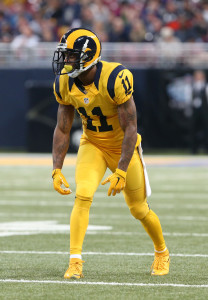 as a first-rounder in 2013. Either way, the Rams decided to pay him like one. Having already picked up his fifth-year option, the front office signed the 25-year-old Austin to a four-year, $42MM extension. The contract ranks 11th among wideouts in total value and total guaranteed money, ahead of names like Antonio Brown, Jordy Nelson, and Brandon Marshall.
as a first-rounder in 2013. Either way, the Rams decided to pay him like one. Having already picked up his fifth-year option, the front office signed the 25-year-old Austin to a four-year, $42MM extension. The contract ranks 11th among wideouts in total value and total guaranteed money, ahead of names like Antonio Brown, Jordy Nelson, and Brandon Marshall.
Austin certainly hasn’t been a disappointment since being selected in the first-round, especially since the unconventional Rams offense doesn’t rely on your standard “number-one” option in the passing game. Austin had his best season in 2015, compiling career-highs in receptions (52), receiving yards (473) and touchdowns (five). Austin also contributed in the running game (compiling 434 rushing yards and four touchdowns on 52 carries) and the punt game, making him a useful offensive weapon.
Other:
The biggest story of the Rams’ offseason was their return to Los Angeles after two decades in St. Louis. The franchise had previously played in California for nearly 50 years, and their move will finally bring back professional football to Los Angeles. The last time a team relocated was in 1997, when the Houston Oilers moved to Memphis (and then to Nashville) and became the Tennessee Oilers/Titans. That Tennessee team (which also featured Jeff Fisher as their head coach) finished that season 8-8.
The Rams brought in receivers coach Mike Groh to replace Ray Sherman. Groh, who has been coaching since 2000, helped Alshon Jeffery evolve into one of the NFL’s top wideouts in Chicago. The hope is that Groh will help improve a unit that finished last in the league in passing yards last season.
Besides picking up Austin’s option, the Rams also exercised linebacker Alec Ogletree‘s fifth-year option. The former first-rounder has established himself as one of the leaders of the Rams defense, even after playing only four games in 2015. In his first two seasons in the league, Ogletree averaged 114 tackles, five forced fumbles, and 11 passes defended. After having extended Austin, the team will surely be looking to lock up the 24-year-old linebacker.
Top 10 cap hits for 2016:
- Trumaine Johnson, CB: $13,952,000
- Robert Quinn, DE: $11,157,373
- Nick Foles, QB: $8,750,000
- William Hayes, DE: $7,000,000
- Michael Brockers, DT: $6,146,000
- Mark Barron, LB: $6,000,000
- Greg Robinson, T: $5,804,754
- Rodger Saffold, G: $5,626,250
- Kenny Britt, WR: $4,850,000
- Coty Sensabaugh, CB: $4,850,000
The Rams did show some promise in 2015, and the front office spent plenty of money to retain many of their top free agents. Conventional wisdom would indicate that the young roster would take another step forward in 2016.
Of course, that team also finished with only seven wins last season. Even if they have a two-win improvement, it might not be enough to emerge in the competitive NFC (especially in a division that features two possible Super Bowl contenders in the Seahawks and Cardinals). Plus, Jeff Fisher has yet to finished better than 7-9 in each of four seasons with the team.
After pairing Jared Goff with Rookie of the Year Todd Gurley, there’s no denying that the future is bright in Los Angeles. However, it still might take a few seasons for the Rams to return to the playoffs for the first time since 2004.
Information from Over the Cap, Spotrac, and Roster Resource was used in the creation of this post. Photos courtesy of USA Today Sports Images.
By Connor J. Byrne |
at September 8, 2016 6:00 pm
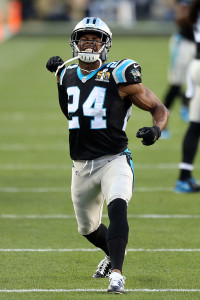
The defending NFC champion Panthers were in the midst of a quiet offseason until general manager Dave Gettleman made the shocking decision in late April to remove the franchise tag from star cornerback Josh Norman, with whom long-term contract talks weren’t progressing. The 28-year-old offered to sign his franchise tender for 2016, but the Panthers had already filed the paperwork to rescind it, thereby allowing Norman to hit the open market and quickly ink a massive deal with Washington.
With most worthwhile free agents off the board by the time Carolina waved goodbye to Norman, the club wasn’t able to make any notable veteran additions to replace him. As a result, the Cam Newton-led Panthers are left to hope a group of less established corners will step up in the wake of Norman’s departure and help them reach even greater heights than they did last season.
Notable signings:
- Paul Soliai, DT: Two years, $6.5MM. $3MM guaranteed.
- J.J. Jansen, LS: Five years, $5.475MM. $700K guaranteed.
- Mike Tolbert, FB. Two years, $3.3MM. $700K guaranteed.
- Gino Gradkowski, C: Three years, $3.15MM. $450K guaranteed.
- Joe Webb, QB/WR: Two years, $1.86MM. $200K guaranteed.
- Chris Scott, G: One year, minimum salary benefit. $30K guaranteed.
- Charles Johnson, DE: One year, $3MM. Was released prior to re-signing.
- Mike Remmers, T: One year, $2.553MM. Signed original-round RFA tender.
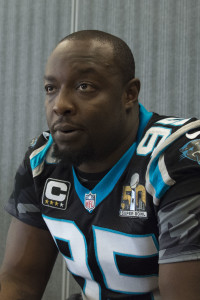
It looked as though defensive end Charles Johnson would precede Norman’s exit when the Panthers released him March 3, but the gamble to ax Johnson in a cost-cutting move ultimately paid off for the club. In releasing Johnson and re-signing him less than a week later on a cheap pact, the Panthers saved $8MM. Johnson, who reportedly turned down more money from other teams, missed seven of 15-1 Carolina’s regular-season games in 2015 and finished with his fewest sacks (one) since his rookie season in 2007, but he did bounce back to take down the opposing quarterback in each of the team’s three playoff contests. Johnson, 30, has 63.5 sacks during his nine-year Panthers career – including anywhere from 8.5 to 11.5 in each season from 2010-14.
Joining Johnson along the Panthers’ defensive line is newcomer Paul Soliai, who is continuing in the NFC South after spending the previous two years with the Falcons. Atlanta released Soliai both because of a high cap hit and an inability to fit into head coach Dan Quinn‘s defense. The 6-foot-4, 345-pounder saw his snaps decrease from 502 in 2014 to 357 last season, Quinn’s first year on the job, but the Panthers are betting he’ll fare well in their system and replace the released Dwan Edwards as durable run-stuffing depth behind Star Lotulelei. Soliai, a nine-year veteran and one-time Pro Bowler, has appeared in no fewer than 14 games in eight straight seasons.
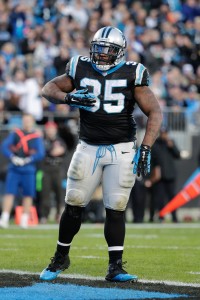
Offensively, both fullback Mike Tolbert and right tackle Mike Remmers inked modest deals to remain in Carolina. As an unrestricted free agent, there was more danger in losing Tolbert, a two-time Pro Bowler who has managed to remain relevant as fullback usage across the NFL has dwindled. The Panthers deployed Tolbert on over 38 percent of their offensive snaps last year, and the 5-9, 250-pounder picked up 454 total yards and four scores on 80 touches (62 rushing, 18 receiving). Tolbert should once again complement Newton and Jonathan Stewart as a useful part of the Panthers’ run-based attack this season.
Remmers, who went undrafted out of Oregon State in 2012, made just one combined appearance with the Buccaneers and Chargers in his first two years before heading to Carolina in 2014. He logged five appearances, all starts, that year and then started each of the Panthers’ games last season. Remmers had an ugly showing in the Panthers’ Super Bowl 50 loss to Von Miller and the Broncos, but he partook in all 1,102 of their snaps during the regular season and graded a solid 39th among Pro Football Focus’ 77 qualified tackles. Carolina then retained Remmers, a restricted free agent, with a second-round tender ($2.553MM).
Read more
Notable losses:
- Frank Alexander, DE
- Jared Allen, DE: Retired
- Nate Chandler, OL: Released
- Jerricho Cotchery, WR
- Dwan Edwards, DT: Released
- Cortland Finnegan, CB
- Roman Harper, S
- Josh Norman, CB: Rescinded franchise tag
- Brad Nortman, P
- Amini Silatolu, G
- Charles Tillman, CB: Retired
- Fernando Velasco, OL
Along with Norman and Edwards, the Panthers’ defense lost four other familiar veterans in end Jared Allen, cornerbacks Charles Tillman and Cortland Finnegan, and safety Roman Harper.
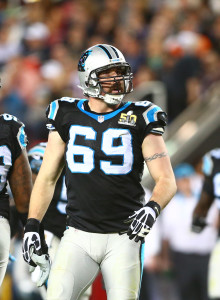
The Panthers acquired Allen, one of the most prolific sack artists ever, in a trade with the Bears last September. Allen then started in all 12 of his regular-season appearances with Carolina, finishing behind only Kawann Short and Kony Ealy in snaps among the team’s defensive linemen, and racked up two sacks. A broken bone in Allen’s foot prevented him from making much of an impact in the playoffs, though, and he subsequently retired. With Allen gone, Ealy’s role could grow even larger after what may have been a coming-out party in the Super Bowl. Although the Panthers lost by two touchdowns, Ealy dominated the Broncos with three sacks, an interception and a forced fumble.
Like Allen, Tillman decided in the offseason to wrap up his excellent career. A longtime Bear, Tillman missed four games in his only season in Carolina, but he still started in each of his 12 appearances and took the field for 711 defensive snaps. That placed him behind only Norman and Bene Benwikere among the Panthers’ corners. All told, Tillman snagged two interceptions and forced two fumbles, though he rated just 64th among PFF’s 111 qualified corners in overall performance. Nevertheless, neither Tillman’s output nor leadership will be easy for the Panthers to replace.
While Finnegan was far less integral to the Panthers’ defense than Tillman was last year, they did rely on him to a notable extent after luring him out of retirement at the end of November. Finnegan amassed 213 snaps during his five regular-season games with the club, which elected against bringing him back as a free agent.
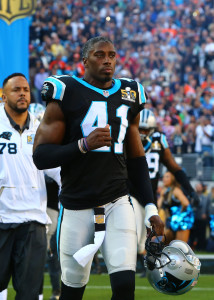
As was the case with Finnegan, the Panthers chose not to re-sign Harper after his contract expired. Harper led Panthers safeties with 951 defensive snaps in 2015, however, and PFF rated him a respectable 45th among its 89 qualified safeties. Harper, who didn’t miss a game or a start in either of his two seasons with the Panthers, is now back with division-rival New Orleans, where he spent the first eight years of his career. The Panthers are counting on Tre Boston to take over for Harper, but Boston hasn’t garnered much experience since going in the fourth round of the 2014 draft. Unsurprisingly, though, Boston relishes his new role.
“It’s what I’ve always wanted and now it’s time to take off with it,” he told Jonathan Jones of the Charlotte Observer last month. “I don’t see it as, ‘Oh this is your first year starting.’ No, I see it as it’s my first time to make plays. Really take over the secondary, really be somebody the league fears.
The Panthers also didn’t re-sign receiver Jerricho Cotchery, who remains a free agent after piling up 87 receptions, 1,065 yards and four touchdowns in two years and 29 regular-season games with the Panthers. Cotchery was third on the team in catches (39) and receiving yards (485) last season, but it has plenty of ability at wideout with Kelvin Benjamin, who missed all of last season with a torn ACL, as well as Devin Funchess, Ted Ginn Jr and Corey Brown.
Trades:
- Acquired P Andy Lee and a 2017 seventh-round pick from the Browns in exchange for P Kasey Redfern and a 2018 fourth-round pick.
- Acquired a 2016 third-round pick (No. 77) and a 2016 fifth-round pick (No. 141) from the Browns in exchange for a 2016 third-round pick (No. 93), a 2016 fourth-round pick (No. 129), and a 2016 fifth-round pick (No. 168).
After letting punter Brad Nortman go in free agency and being unimpressed with would-be replacement Mike Scifres‘ summer production, the Panthers swung a deal last week to send a 2018 fourth-round pick to Cleveland for Andy Lee and a 2017th seventh-rounder (the other play in the trade, Kasey Redfern, is now a free agent). Lee, 34, spent the first 11 seasons of his career with the 49ers before the Browns acquired him last year. The veteran averaged 46.7 yards per punt, slightly higher than his career average, in Cleveland. During his earlier days, Lee accumulated three first-team All-Pro nods and two Pro Bowl selections.
Draft picks:
- 1-30: Vernon Butler, DT (Louisiana Tech)
- 2-62: James Bradberry, DB (Samford)
- 3-77: Daryl Worley, CB (West Virginia)
- 5-141: Zack Sanchez, CB (Oklahoma)
- 7-252: Beau Sandland, TE (Montana State)
With a limited number of picks (five) in this year’s draft, the Panthers focused heavily on the defensive side of the ball. Their first selection, D-tackle Vernon Butler, will be an understudy to Short this season, though it’s possible he’ll take over for the veteran soon. Short’s in a contract year, which means this could be the standout’s last season in Carolina. Regardless, Butler will get his fair share of playing time this year as head coach Ron Rivera and defensive coordiantor Sean McDermott seek to keep their linemen fresh.
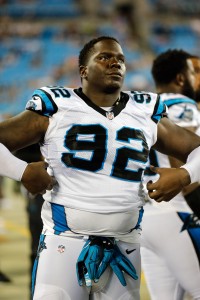
In assessing Butler, formerly of Louisiana Tech, our own scouting guru, Dave-Te Thomas, wrote, “Butler is a highly competitive sort who relishes his role as the defense’s “garbage man,” taking on multiple blockers constantly to free up a fellow Bulldog defender to make the play. He is simply unstoppable when he charges through the gaps and uses his hands with tremendous force when facing constant double teams. Some scouts were concerned about his gas tank late in games, but he worked hard during the 2015 offseason to get his weight down in order to eliminate his “tired legs” issue.
His strength at the point of attack is one of his best assets, as I have yet to see any blocker, or blockers, capable of riding him out once he anchors and establishes position in the trenches. He doesn’t use his violent hand punch as much as he should, but he can easily obliterate any blocker once he gets his hands into their body. He is the type that will rarely ever get bounced around by double teams, thanks to his overall strength and ability to remain at a low pad level. With his big, strong hands, body mass and aggression, Butler excels at shutting down the interior running game.”
To address their weakened secondary, the Panthers spent their second-, third- and fifth-rounders on cornerbacks. The first two, James Bradberry and Daryl Worley, are likely to start immediately. The third, Zack Sanchez, is now on the Panthers’ practice squad.
Of Bradberry, an ex-Samford star, Thomas wrote, “The reason for his instant success in Panthers camp is the fact that Bradberry is a smart, instinctive, and tough football player, one who diagnoses plays quickly and frequently a step ahead of the receivers. He is a physical tackler who can jam receivers when asked to line up in press coverage and he has the closing burst, along with awareness and positioning to make plays on the ball in flight, showing that second gear needed to run with receivers downfield.”
After landing Bradberry, the Panthers liked Worley enough to move up for him by way of a deal with the Browns, to whom they traded the 93rd, 129th and 168th selections in the draft for Nos. 77 and 141 (used to take Sanchez). Worley was a playmaker at West Virginia, where he intercepted 10 passes in three seasons and concluded his Mountaineers tenure with a Big 12-leading six last year.
Per Thomas: “Worley is a natural playmaker with soft hands for the interception, one who times his leaps well and can snatch the ball out of the air. He demonstrates good body control to make the catch outside of his frame and looks natural with the ball in his hands, along with possessing a good feel for the return and the vision to set up blocks. He has the agility and quick burst to accelerate, which makes him a reliable open-field tackler who can break down in space well and wrap his arms securely.”
Extensions and Restructures:
The Panthers locked up three core members of their roster during the offseason, inking center Ryan Kalil, offensive tackle Michael Oher and safety Kurt Coleman to extensions that will keep them in the fold for a few more seasons apiece.
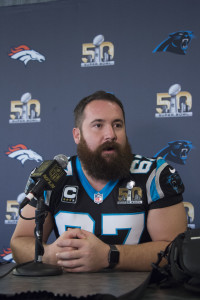
Kalil, whom the Panthers chose in the second round of the 2007 draft, has started in all of his appearances since his second season. Fifteen of those starts came last year for Kalil, who earned his fifth Pro Bowl selection and second career first-team All-Pro nod in 2015.
After a down season in Tennessee, Oher took a two-year, $7MM deal with Carolina in 2015 and parlayed a 16-start campaign at left tackle into a much more lucrative contract earlier this summer. PFF graded Oher, 30, as one of the league’s 30 best O-tackles last season after he helped protect Newton’s blind side and block for an elite ground attack.
A month after securing Kalil and Oher, the Panthers awarded a new accord to Coleman, who posted a career year in his first season in Carolina. The former Eagle and Chief started in all of his appearances and totaled seven interceptions, one of which he returned for a touchdown, during the regular season. Coleman, 28, has quickly become the most established member of a Panthers secondary that no longer includes Norman, Tillman, Finnegan or Harper.
Other:
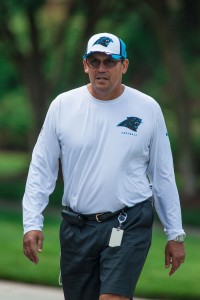
In addition to extending multiple key players, the Panthers did the same with Rivera, whose five-year tenure has been a resounding success. “Riverboat Ron,” a nickname he earned after adopting a more aggressive approach in 2013, has helped the Panthers to a 47-32-1 regular-season record, three straight NFC South titles and a conference championship. Along the way, Rivera has picked up AP NFL Coach of the Year honors twice. With a three-year, $19.5MM deal in hand, he’s now one of the league’s highest-paid coaches.
“It was an easy decision,” Gettleman said of extending Rivera. “Ron has worked extremely hard and we are thrilled with our current direction.”
One player Rivera will coach through at least 2017 is Lotulelei, whose fifth-year option the Panthers exercised in April. Lotulelei has been a full-time starter for the Panthers since they chose him 14th overall in the 2013 draft. In 14 games in 2015, the 26-year-old recorded 22 tackles to go with a sack, a forced fumble and a fumble recovery. Notably, PFF rated Lotulelei just 90th among 123 qualified interior D-linemen, though a foot injury may have weighed him down. Lotulelei underwent surgery in January 2015, dealt with complications in training camp, and then missed the first two games of the season.
Top 10 cap hits for 2016:
- Cam Newton, QB: $19.500,000
- Ryan Kalil, C: $11,829,000
- Jonathan Stewart, RB: $9,550,000
- Thomas Davis, LB: $7,500,000
- Luke Kuechly, LB: $6,000,000
- Greg Olsen, TE: $5,100,000
- Michael Oher, T: $4,500,000
- Charles Johnson, DE: $4,020,000 (dead money)
- Graham Gano, K: $3,850,000
- Star Lotulelei, DT: $3,055,977
The Panthers likely lost more ground than they gained during the offseason, but they’re still among the league’s top-tier teams on paper and should once again be on the short list of Super Bowl contenders. Expecting another 15-win regular season is unrealistic, of course, but with Newton – the reigning MVP – at the helm of a highly talented roster, a fourth consecutive NFC South crown looks like an inevitability.
Information from Over the Cap, Spotrac, and Roster Resource was used in the creation of this post. Photos courtesy of USA Today Sports Images.
By Dallas Robinson |
at September 6, 2016 9:00 pm
The Redskins entered their second offseason under general manager Scot McCloughan, and while the club has shown an interest in developing a draft-based approach — as opposed to targeting high-priced free agents — Washington had to deal with the impending free agency of its franchise quarterback, and weigh a pursuit of a veteran defensive back who unexpectedly hit the open market.
Notable signings:
- Josh Norman, CB: Five years, $75MM. $36.5MM guaranteed.
- Kirk Cousins, QB: One year, $19.953MM. Fully guaranteed. Accepted franchise tag.
- David Bruton, S: Three years, $9MM. $3.4MM guaranteed.
- Colt McCoy, QB: Three years, $9MM. $1.8MM guaranteed.
- Vernon Davis, TE: One year, $2.4MM. $1.1MM guaranteed. $2.1MM available via incentives.
- Kendall Reyes, DE: One year, $2.5MM. $1MM guaranteed.
- Mason Foster, LB: Two years, $2.5MM. $350K guaranteed.
- Will Blackmon, CB: Two years, $2.05MM. $150K guaranteed.
- Greg Toler, CB: One year, minimum salary benefit. $80K guaranteed.
- Terence Garvin, LB: One year, $750K. $75K guaranteed.
- Ziggy Hood, DL: One year, minimum salary benefit. $20K guaranteed.
- Junior Galette, LB: One year, $1.6MM. $2.5MM available via incentives.
- Duke Ihenacho, S: One year, $675K.
- Kedric Golston, DT: One year, minimum salary benefit.
The Redskins didn’t wade very deeply into the free agent waters, choosing to spend their money at lower end of the market. However, the club did make two exceptions to that strategy, and each was its own unique situation. The first was on offense, where Washington retained its quarterback — fifth-year pro Kirk Cousins — via the franchise tag after the two sides couldn’t come to an agreement on a long-term deal.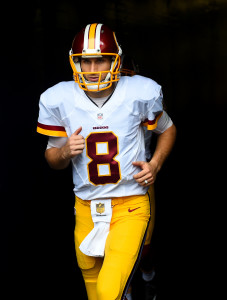
It’s not surprising that that Cousins and the Redskins couldn’t come to a middle ground on his value given that he only has one full season of starting experience (and only one half-season of exceptional play). Washington was reportedly offering an extension that contained $24MM in guarantees and a $16MM per year salary, but given that the franchise tag will pay Cousins nearly $20MM in 2016 alone, he had no reason to accept such a proposal.
Both the club and Cousins seem content with the idea of him playing out the year under the tag, and the issue will clearly be revisited next offseason. If the Redskins want to place the franchise tender on Cousins again in 2017, they’d have to be willing to pay him almost $24MM (120% the value of the 2016 tag). But the more likely scenario — if Cousins plays well once again — entails the two parties coming to terms on an extension.
While Cousins is only locked up for one season, Washington signed cornerback Josh Norman for the next five years, agreeing to a $75MM contract with the All Pro after the Panthers rescinded the franchise tag. 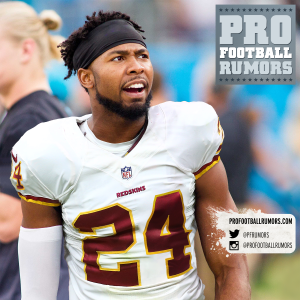 The deal contains $36.5MM in full guarantees, but nearly 60% of that total comes in the form of guaranteed 2016 and 2017 base salaries. As such, the Redskins could conceivably exit the deal after two seasons without much dead money being left on the cap.
The deal contains $36.5MM in full guarantees, but nearly 60% of that total comes in the form of guaranteed 2016 and 2017 base salaries. As such, the Redskins could conceivably exit the deal after two seasons without much dead money being left on the cap.
If Norman continues his current level of play, of course, Washington won’t have any reason to get out of the contract. Norman, 28, enjoyed a career-year in 2015 as he was named to the All Pro first team and selected for his first Pro Bowl. He produced career highs in both interceptions (four) and passes defensed (18), and was well-regarded by advanced metrics as well, finishing as the league’s 12th-best corner by Pro Football Focus’ grades.
Norman wasn’t the only addition the Redskins made to their secondary, as the club also agreed to terms with former Broncos safety David Bruton. Nearly 30 years old, Bruton has never been a full-time starter during his NFL career, 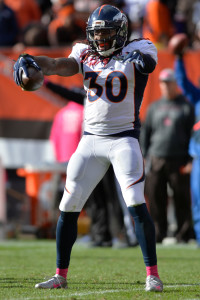 but he’ll get that opportunity now opposite DeAngelo Hall. Denver played a bunch of three-safety looks last year, so Bruton did see action on more than 40% of snaps in 2015. Meanwhile, Will Blackmon, Greg Toler, and Duke Ihenacho will all vie for rotational snaps in the defensive backfield while adding value on special teams.
but he’ll get that opportunity now opposite DeAngelo Hall. Denver played a bunch of three-safety looks last year, so Bruton did see action on more than 40% of snaps in 2015. Meanwhile, Will Blackmon, Greg Toler, and Duke Ihenacho will all vie for rotational snaps in the defensive backfield while adding value on special teams.
Washington also made several cheap signings along the front seven, and two of them — defensive lineman Ziggy Hood ($20K guaranteed) and Kedric Golston (no guaranteed money) — are listed as starters on the club’s official depth chart that was released today. Along with fellow new addition Kendall Reyes and holdovers Ricky Jean-Francois and Anthony Lanier, the Redskins figure to rotate their defensive lineman quite a bit in order to keep everyone fresh.
Two re-signings that didn’t make much sense were tight end Vernon Davis and linebacker Mason Foster. Davis, 32, has a familiarity with McCloughan from the pair’s time in San Francisco, but the veteran tight end looked completely lost with both the 49ers and Broncos last season. Clearly, he won’t be asked to be a No. 1 option with Jordan Reed in tow, but $1.1MM in guarantees is not an insignificant amount of money. Foster, meanwhile, wasn’t very effective after being signed last September, and other free agent options such as Craig Robertson or Zach Brown could have been more cost-effective moves.
Continue reading about the Redskins’ offseason…
Read more
Notable losses:
- Tom Compton, T
- Chris Culliver, CB: Released
- Brian De La Puente, C
- Dashon Goldson, S: Released
- Robert Griffin III: Released
- Jason Hatcher, DL: Released, then retired
- Adam Hayward, LB: Released
- Jackson Jeffcoat, DE: Waived
- Jeron Johnson, S: Released
- Frank Kearse, DE
- Terrance Knighton, DT
- Alfred Morris, RB
- Stephen Paea, DE: Released
- Perry Riley, LB: Released
- Andre Roberts, WR: Released
- Keenan Robinson, LB
- Alex Smith, TE
- Pierre Thomas, RB
- Cary Williams, CB
- Darrel Young, FB
In terms of persona and public image, Robert Griffin III can be considered a “notable loss,” but based solely on on-field impact, the former Offensive Rookie of the Year won’t be missed, as he didn’t play a single snap last season. Obviously, that was by design, as the Redskins didn’t want to risk RG3’s injury guaranteed 2016 salary to kick in. Griffin was never a great fit for head coach Jay Gruden‘s offensive system, and with Kirk Cousins now the lead dog in Washington, RG3 will try to restart his career in Cleveland.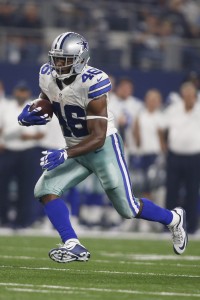
The Redskins also lost a couple key members from their backfield, as Alfred Morris defected to the division rival Cowboys while Pierre Thomas remains on the open market. Like RG3, Morris was never able to match his rookie season, when he rushed for more than 1,600 yards and 13 touchdowns. But as a back with limited ability in the passing game, Morris wasn’t going to mesh with Gruden’s offense. Thomas, meanwhile, is still a candidate to be re-signed if Washington doesn’t want move forward with only Rob Kelley and Chris Thompson behind Matt Jones.
Most of Washington’s losses came on the defensive side of the ball, as the club saw players leave at each level of the unit. Up front, Jason Hatcher retired, Terrance Knighton left via free agency (though he’s now available once again after being cut by the Patriots), and Stephen Paea was released at final cutdowns. The 34-year-old Hatcher was probably the best of the bunch in 2015, as he started 14 games and graded as the No. 27 interior defender according to Pro Football Focus.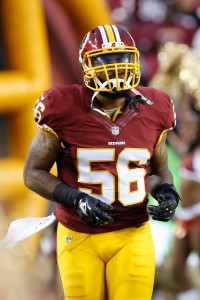
Linebacker Perry Riley was released at the same time as Paea, and Washington saved a considerable amount of money by moving on from him. Riley will leave a sizable void in the middle of the club’s defense, however, as he’d started 63 games during his six-year tenure with the Redskins. Keenan Robinson, meanwhile, is also gone after playing more than half of Washington’s snaps last season. He’ll suit up for the division rival Giants in 2016.
In the back end, Washington parted ways with veteran safety Dashon Goldson, who played more than 90% of the club’s defensive snaps but rated as one of the four worst safeties in the league, per PFF. He headed south to join the Falcons, whereas cornerback Chris Culliver — released earlier this year — signed on with the Dolphins. Culliver signed a four-year, $32MM contract with Washington in May 2015, ultimately playing out just one season of that deal. His $8MM guaranteed salary for 2016 was voided when the cornerback was suspended one game for a 2014 incident, and with Culliver coming off a torn ACL, the decision for the Redskins was simple.
Trades:
- Acquired a 2016 first-round pick (No. 22) and a 2017 sixth-round pick from the Texans in exchange a 2016 first-round pick (No. 21).
- Acquired a 2016 fifth-round pick (No. 152) and a 2017 fifth-round pick from Saints in exchange for a 2016 fourth-round pick (No. 120).
- Acquired a 2017 fourth-round pick from the Jets in exchange for a 2016 fifth-round pick (No. 158).
Draft picks:
Josh Doctson was viewed by many observers as the best wide receiver available in this year’s draft, but he ended up being the third pass-catcher to come off the board after Corey Coleman and Will Fuller. He’s a bit older than your average rookie — he’ll be 24 in December — but Doctson has a fan in scouting guru Dave-Te Thomas, who offered this analysis on Doctson earlier this year:
He lacks outstanding speed, but Doctson is a smooth route runner with the ability to stretch the field and separate, along with the natural hands needed to make the difficult catches. He displays above average balance and crisp change of direction agility to gain valid yardage after the catch and has the ability to extend while tip-toeing along the sidelines for the soft pluck. He does a good job of gaining separation off the snap due to his initial quick step. The thing you see on the field is his natural feel for making adjustments on the move, displaying good fakes and a bit of con in him to set up defensive backs in attempts to get open.
Doctson is unlikely to be a starter immediately as he deals with an injury and plays behind DeSean Jackson, Pierre Garcon, and Jamison Crowder, and Washington’s mid-round picks don’t project to play early in their rookie seasons, either. Second-rounder Su’a Cravens is expected to be used in a hybrid linebacker/safety role (think Deone Bucannon), while third-rounder Kendall Fuller will be a reserve corner.
Cutting a fifth-round pick isn’t the end of the world, but it’s a little surprising that Matt Ioannidis wasn’t able to force his way into a defensive line group that is rather thin. Instead, he’ll start his rookie year on the practice squad after clearing waivers. Nate Sudfeld will be the Redskins’ third quarterback behind Kirk Cousins and Colt McCoy, while Steven Daniels and Keith Marshall will spend their rookie seasons on injured reserve.
Extensions and Restructures:
After agreeing to an extension that will keep him in the nation’s capital through 2021, Jordan Reed is now the third-highest paid tight end in terms of annual salary, trailing only Jimmy Graham and (barely) Travis Kelce. The Redskins gave Reed a $9MM signing bonus, and as they often do, guaranteed his first two years of base salary. Reed was also able to secure $22MM in injury guarantees, an important concession given his history of health concerns.
After being limited to just 20 overall games in 2013 and 2014, Reed stayed healthy for 14 games last season, racking up 87 receptions for 952 yards and 11 touchdowns. In spite of Reed’s injury history, he always seemed destined for a lucrative long-term extension, with Travis Kelce and Zach Ertz having already signed new mega-deals this offseason — neither of those tight ends matched the impressive numbers that the Washington pass-catcher put up in 2015.
Reed had been preparing to enter the final year of his rookie contract, and would have earned a base salary of $1.661MM in 2016 under the terms of his old deal. Extending him this offseason allowed Washington to apply some of the new money in the extension to the 2016 cap, increasing Reed’s previous $1.808MM cap charge, in addition to allowing the tight end to get paid a year early.
Other:
Junior Galette just can’t catch a break — after tearing his Achilles last August and missing what was supposed to be his first season with the Redskins, he suffered another Achilles injury earlier this year and will miss 2016 as well. If healthy, Galette can be a force rushing from the edge, but his recent ailments 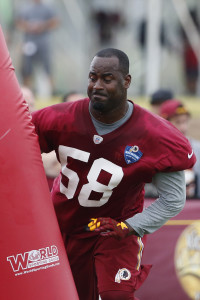 are going to severely limit his market next spring. His contract didn’t contain any guaranteed money, and it’s unclear if he’ll earn his entire $1.6MM salary/roster bonus given that he’s on injured reserve.
are going to severely limit his market next spring. His contract didn’t contain any guaranteed money, and it’s unclear if he’ll earn his entire $1.6MM salary/roster bonus given that he’s on injured reserve.
Offensive lineman Bryan Stork, meanwhile, also saw his offseason severely affected by injury concerns. The Patriots were reportedly set to waive the 25-year-old center when the Redskins swooped in and offered a conditional seventh-round draft pick. After being dealt, Stork apparently considered retirement before opting to give it a go with Washington. However, Stork failed his physical with the Redskins and the trade was rescinded, and Stork has since been waived by New England.
All those failed machinations show that the Redskins are clearly looking to upgrade the center position. They forced incumbent Kory Lichtensteiger to take a pay cut, and though it’s not ideal to change up an offensive line during a season, it’s always possible the club signs a free agent later this year. Backup guard Spencer Long has also been taking snaps at center, so he’d likely be the next man up if Lichtensteiger struggles.
Top 10 cap hits for 2016:
- Kirk Cousins, QB: $19,93,000
- Trent Williams, T: $10,668,750
- Pierre Garcon, WR: $10,200,000
- DeSean Jackson, WR: $9,250,000
- Ryan Kerrigan, LB: $8,450,000
- Josh Norman, CB: $8,000,000
- DeAngelo Hall, DB: $5,062,5000
- Perry Riley, LB: $5,049,804
- Shawn Lauvao, G: $5,000,000
- Brandon Scherff, G: $4,821,736
The Kirk Cousins negotiations took up most of the Redskins’ offseason, but the club was able to add a decent amount of defensive depth while also bringing in a star in Josh Norman. The production of those two players will likely determine whether Washington’s offseason is considered a failure or a success, but the Redskins are working on building a complete roster. With Tony Romo sidelined in Dallas, the Eagles undergoing a rebuild, and the Giants engaged in a yearly battle with mediocrity, the Redskins can probably be considered the favorites in the NFC East.
Information from Over the Cap, Spotrac, and Roster Resource was used in the creation of this post. Photos courtesy of USA Today Sports Images.
By Zachary Links |
at August 30, 2016 2:40 pm
After one of the busiest offseasons in the NFL, the Titans are looking to take one major step forward in their rebuilding process.
Notable signings:
- Ben Jones, C: Four years, $17.5MM. $7.5MM guaranteed.
- Al Woods, DT: Three years, $10.5MM. $3.75MM guaranteed.
- Rishard Matthews, WR: Three years, $15MM. $2.5MM guaranteed.
- Brice McCain, CB: Two years, $4.4MM. $1MM guaranteed.
- Matt Cassel, QB: One year, $2MM. $750K guaranteed.
- Sean Spence, LB: One year, $2.5MM. $500K guaranteed.
- Rashad Johnson, S: One year, $2MM. $500K guaranteed. $1MM available via incentives.
- Antwon Blake, CB: One year, $1.5MM. $200K guaranteed.
- Andre Johnson, WR: Two years, $2.985MM.
There was lots of activity in Tennessee over these last few months, but relatively little happening on the free agent market. One notable move they did make was the signing of center Ben Jones, which strengthened their interior line while hurting the rival Texans. Given the season-ending injury suffered by presumptive starter Nick Martin, the loss of Jones will sting extra hard in Houston. 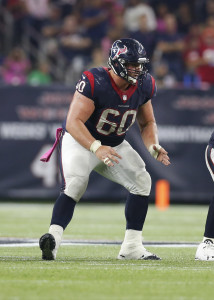
Jones, 26, was with the Texans since 2012, when he entered the league as a fourth-round pick out of Georgia. He became Houston’s full-time starter in 2014, and he’s started all 32 games since. Jones posted solid marks from Pro Football Focus, which ranked him as the No. 18 center in the league last season, noting that he was better in the pass game than as a run-blocker.
Early on in free agency, the Titans re-signed defensive tackle Al Woods to a three-year pact. Woods, who recently turned 29, picked up 22 tackles in 14 games (nine starts) for the Titans in 2015. With fellow nose tackle Sammie Lee Hill recovering from a knee injury to open the season, Woods saw most of the playing time at the position, earning 362 defensive snaps to Hill’s 190 for the season. While Pro Football Focus ranked Woods just 88th out of 123 interior defenders, PFF gave him a solid grade as a run defender, and he was primarily used on early downs. At the time of his new deal, it looked like Woods would be slotted in as the team’s starting nose tackle. However, the Titans found their new starter in the draft (more on that later).
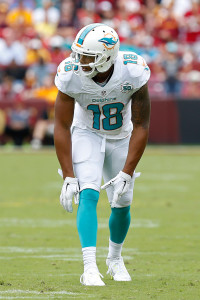 Wide receiver Rishard Matthews was a pleasant surprise for Dolphins fans and fantasy owners alike in 2015. In 11 contests last season, Matthews totaled 662 yards and averaged 15.4 per reception as the Fins’ downfield complement to Jarvis Landry. Unfortunately, a season-ending injury later in the season ended his breakout campaign prematurely. That bad break also may have capped his free agent market somewhat. Ultimately, the Titans were able to sign Matthews to a three-year deal with a paltry $2.5MM guaranteed. After Dorial Green-Beckham was jettisoned to Philly, Matthews probably now stands as the team’s No. 1 wide receiver.
Wide receiver Rishard Matthews was a pleasant surprise for Dolphins fans and fantasy owners alike in 2015. In 11 contests last season, Matthews totaled 662 yards and averaged 15.4 per reception as the Fins’ downfield complement to Jarvis Landry. Unfortunately, a season-ending injury later in the season ended his breakout campaign prematurely. That bad break also may have capped his free agent market somewhat. Ultimately, the Titans were able to sign Matthews to a three-year deal with a paltry $2.5MM guaranteed. After Dorial Green-Beckham was jettisoned to Philly, Matthews probably now stands as the team’s No. 1 wide receiver.
Matthews isn’t the only Miami import as the Titans also signed cornerback Brice McCain. McCain started 10 games and played 735 defensive snaps for the Dolphins in 2015, picking up an interception to go along with 39 tackles. However, the Dolphins decided to cut him this year in order to save $2.5MM against the cap. Despite making 10 starts for Miami last year, he’ll play a reserve role this year behind starters Jason McCourty and Perrish Cox.
The Titans reportedly made quarterback Matt Cassel a priority in free agency as they wanted to shore up the quarterback position behind Marcus Mariota. Evidently, the Cassel signing was made so that the Titans could move on from Zach Mettenberger later on in the offseason.
Read more
Notable losses:
- Zach Brown, LB
- Michael Griffin, S: Released
- Brandon Harris, CB
- Steven Johnson, LB
- Sammie Lee Hill, DT
- Joe Looney, C
- Mike Martin, DT
- Jamon Meredith, G
- Zach Mettenberger, QB: Waived
- Ropati Pitoitua, DL: Released
- Coty Sensabaugh, CB
- Craig Stevens, TE: Retired
- Blidi Wreh-Wilson, CB: Waived
Michael Griffin managed to start 14 games for Tennessee last season, accruing 65 tackles, one interception, and one sack, but he is not the player that he once was. In February, the Titans cut him loose in order to clear his entire $6.5MM salary from the books for 2016. In his nine seasons with the Titans, Griffin missed just three games, including one in 2015. Earning Pro Bowl spots in 2008 and 2010, the former first-round pick totaled 761 tackles, 25 interceptions, and 11 forced fumbles during his time with the team. The Titans will miss the hard-working Griffin in the locker room but the move was a no-brainer from a fiscal perspective. 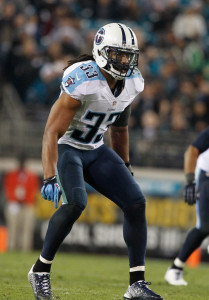
At one time, Zach Mettenberger was viewed as a starting option for the Titans at quarterback. However, he failed to impress on the field and the addition of stud rookie Marcus Mariota in 2015 effectively blocked him in Tennessee. Apparently, the Titans didn’t think much of him as a backup QB either. Mettenberger was waived by the Titans and claimed by the Chargers, only to be waived again by San Diego in late August.
Early on in the offseason when we ranked our top 15 free agent cornerbacks, Coty Sensabaugh did not make the cut. Apparently, the Rams see something that we don’t. Sensabaugh inked a three-year deal with a $15MM base value that could be worth up to $19MM. In 2015, Sensabaugh recorded 58 total tackles with 8 passes defended. He also hauled in two interceptions and scored one defensive touchdown. It’s not clear if the Titans made a major effort to re-sign him.
Sammie Lee Hill played in 10 games for the Titans, starting five, and picked up six tackles. The Titans didn’t express much interest in re-signing him and this week he was slapped with a four-game suspension for a missed drug test. Hill is still without an NFL team for the coming season.
Trades:
- Acquired RB DeMarco Murray and a 2016 fourth-round pick (No. 113) from the Eagles in exchange for a 2016 fourth-round pick (No. 100).
- Acquired OL Dennis Kelly from the Eagles in exchange for WR Dorial Green-Beckham.
- Acquired a 2016 first-round pick (No. 15), two 2016 second-round picks (Nos. 43 and 45), a 2016 third-round pick (No. 76), a 2017 first-round pick, and a 2017 third-round pick from the Rams in exchange for a 2016 first-round pick (No. 1), a 2016 fourth-round pick (No. 113), and a 2016 sixth-round pick (No. 177).
- Rams will also acquire a 2017 seventh-round pick if they send their own 2017 third-rounder to the Titans, rather than a third-round comp pick.
- Acquired a 2016 first-round pick (No. 8) and a 2016 sixth-round pick (No. 176) from the Browns in exchange for a 2016 first-round pick (No. 15), a 2016 third-round pick (No. 76), and a 2017 third-round pick.
- Acquired a 2015 fifth-round pick (No. 157) and a 2016 seventh-round pick (No. 253) from the Broncos in exchange for a 2016 sixth-round pick (No. 176) and a 2017 sixth-round pick.
In 2014, DeMarco Murray was an absolute beast for the Cowboys. Behind one of the league’s best offensive lines, Murray established career-highs of 1,845 yards and 13 TDs in his contract year, leading to a huge payday with the Eagles. Unfortunately, he never took off in Philly, rushing for just 702 yards and six touchdowns in 2015. Even though the Eagles overhauled everything this offseason, Murray still wasn’t happy and in March he was traded to the Titans. All it cost Tennessee was a swap of fourth round picks, moving them down 13 spots. 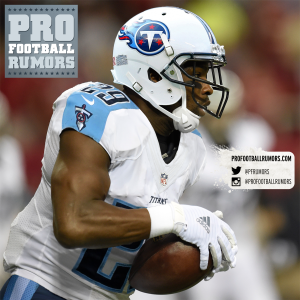
In Tennessee, Murray joins a club that ranked 25th in rushing yards last season and 17th in per-carry average. Keep in mind, that is with Marcus Mariota beefing up both stats with his lofty 7.4 YPC. Antonio Andrews led Titans backs in attempts (143), yards (520) and touchdowns (three). He matched Murray with a paltry 3.6 YPC. If the Titans can get anything close to the 2014 version of Murray, they could have a dangerous offensive attack.
The Titans initially held the No. 1 pick in the 2016 draft and they were heavily connected to Ole Miss tackle Laremy Tunsil. GM Jon Robinson told every live microphone that he intended on keeping the No. 1 pick, a wise play with several teams interested in this year’s top quarterbacks. Eventually, the Rams made a godfather offer to the Titans, netting them a bevy of picks in this year’s draft plus 2017 first-round and third-round selections. Then, the Titans went from No. 15 back up to No. 8 to get the guy who they believed to be one of the best two tackles in the bunch.
The Titans tried to be as patient as they could with Dorial Green-Beckham, but they gave up on the young receiver just days ago. Once considered to be one of the top high school prospects in the nation, DGB was unable to get his head on straight in college and fell to the Titans in the second round of the 2015 draft. Green-Beckham hauled in 32 catches for 549 yards and four touchdowns as a rookie last season, but frustrated coaches with his uneven effort.
Draft picks:
- 1-8: Jack Conklin, T (Michigan State):
- 2-33: Kevin Dodd, DE/OLB (Clemson)
- 2-43: Austin Johnson, DL (Penn State)
- 2-45: Derrick Henry, RB (Alabama)
- 3-64: Kevin Byard, DB (Middle Tennessee State)
- 5-140: Tajae Sharpe, WR (Massachusetts)
- 5-157: LeShaun Sims, CB (Southern Utah)
- 6-193: Sebastian Tretola, OL (Arkansas)
- 7-222: Aaron Wallace, LB (UCLA)
- 7-253: Kalan Reed, DB (Southern Mississippi)
When you have a stud quarterback like Mariota, you need to invest your resources in protecting him. The Titans did just that this year when they moved all around the draft board and ultimately landed at No. 8 to select Michigan State tackle Jack Conklin. The door is open for Conklin to step in immediately and make an impact as a starter on the Titans’ O-Line. Still, as PFR scouting guru Dave-Te Thomas notes, Conklin’s draft position does not necessarily guarantee that he’ll be a star:
Being a Top Ten choice does not always spell instant success, at least where offensive tackles are concerned. Among the 179 offensive tackles to ever be drafted in the first round, four never even played in any NFL games and seven others never started any contests during their pro careers. Since the 1970 draft, five other first round offensive tackle selections never reached double-digit starting figures.
Aside from Conklin, Thomas says he is particularly impressed by defensive tackle Austin Johnson, running back Derrick Henry, free safety Kevin Byard, wide receiver Tajae Sharpe, and guard Sebastian Tretola. Those with a pessimistic view of Murray believe that Henry could be in store for a monster rookie season.
Extensions and Restructures:
Other:
Out with the old, in with the new. Ruston Webster joined the Titans in 2010 as VP of player personnel and was elevated to the GM job two seasons later. The team went on to have an 18-46 record during his tenure, tying them for the second worst mark in the NFL during that time. This offseason, it wasn’t a huge surprise when Webster was bumped in favor of Robinson. R
Robinson spent the bulk of his career with the Patriots, where he worked with Buccaneers GM Jason Licht. It was Licht who later brought Robinson to Tampa. Robinson, a Union City, Tenn., native, was considered a frontrunner early on in the process.
The Titans wrestled with the decision to retain interim head coach Mike Mularkey for the coming year. Team ownership was in Mularkey’s corner from the start and Robinson reportedly agreed to consider him as a serious candidate upon his hiring. The 54-year-old Mularkey now becomes a full-time head coach for the third time in his NFL career — he previously lead both the Bills and Jaguars. A longtime offensive coordinator and tight ends coach, Mularkey has accrued an uninspiring 18-39 record, including a 2-7 mark in nine games as the Titans’ interim coach in 2015.
Top 10 cap hits for 2016:
- Jason McCourty, CB: $8,800,000
- Brian Orakpo, LB: $8,250,000
- Jurrell Casey, DT: $8,120,000
- Kendall Wright, WR: $7,320,000
- Derrick Morgan, LB: $6,312,500
- Delanie Walker, TE: $6,267,708
- Da’Norris Searcy, S: $6,125,000
- DeMarco Murray, RB: $6,000,000
- Perrish Cox, CB: $5,833,333
- Marcus Mariota, QB: $5,503,176
Information from Over the Cap, Spotrac, and Roster Resource was used in the creation of this post. Photos courtesy of USA Today Sports Images.
By Zachary Links |
at August 30, 2016 12:52 pm
After a 6-10 finish in 2015, the Giants made a coaching change and spent like crazy in free agency to right the ship. Will it be enough to put Big Blue back in the postseason?
Notable signings:
- Olivier Vernon, DE: Five years, $85MM. $40MM guaranteed.
- Janoris Jenkins, CB: Five years, $62.5MM. $28.8MM guaranteed.
- Jason Pierre-Paul, DE: One year, $10MM. $8.5MM guaranteed. $500K available via incentives.
- Jasper Brinkley, LB: One year, $1.8MM. $1.7MM guaranteed.
- Josh Brown, K: Two years, $4MM. $1MM guaranteed. $750K available via incentives.
- Keenan Robinson, LB: One year, $2.6MM. $1MM guaranteed. $900K available via incentives.
- Will Johnson, FB: Two years, $2.3MM. $500K guaranteed.
- Zak DeOssie, LS: One year, $1.1MM. $275K guaranteed.
- Leon Hall, CB: One year, $1.5MM. $115K guaranteed.
- Kelvin Sheppard, LB: One year, minimum salary benefit. $80K guaranteed.
- Bobby Rainey, RB: One year, minimum salary benefit. $40K guaranteed.
- Larry Donnell, TE: One year, $1.671MM. Signed original-round RFA tender.
- B.J. Daniels, QB/WR: Two years, $1.29MM.
- Randy Bullock, K: One year, minimum salary benefit.
- Byron Stingily, T: One year, minimum salary benefit.
- Ryan Seymour, OL: One year, $600K.
The cost of edge rushers goes up year and after year and the Giants set a new watermark this offseason when they signed free agent Olivier Vernon. Vernon’s five-year deal is worth $85MM overall with $40MM+ in guaranteed cash, the largest guarantee of any free agent in the 2016 class. Though Malik Jackson‘s $85.5MM deal technically edged him out for overall base value, Vernon probably got the better deal. 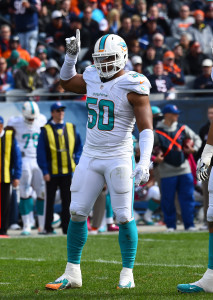
Vernon ranked third overall behind only Khalil Mack and Von Miller among edge defenders last season, according to Pro Football Focus, after amassing 7.5 sacks and 61 tackles. That puts the former Dolphin in elite company, though a pessimist would note that Vernon has only topped 10 sacks once in his career (11.5 in 2013) and $40MM+ guaranteed is a lot for a guy who doesn’t have a history of elite sack production. Regardless, Vernon is a difference-maker and one of the league’s best bookends any way you slice it. The giant deal may not prove to be a wise investment in the long run, but there’s little doubt that it will reignite the Giants’ pass rush in 2015.
 On the first day of free agency, the Giants pounced to sign Janoris Jenkins, a player widely considered to be the best cornerback in this year’s class. The Rams, choosing to put their funds elsewhere and their faith in Trumaine Johnson, only offered Jenkins a a five-year offer worth about $45MM. Jenkins wisely declined and entered the open market, where he got a whopping $62.5MM over five years with nearly $29MM guaranteed. In Jenkins, the Giants got a top cornerback who doesn’t turn 28 until October. Now, the Giants will have Jenkins and Dominique Rodgers-Cromartie in the secondary (plus a promising first-round choice – more on that later) and that will force opposing quarterbacks to think twice before they throw.
On the first day of free agency, the Giants pounced to sign Janoris Jenkins, a player widely considered to be the best cornerback in this year’s class. The Rams, choosing to put their funds elsewhere and their faith in Trumaine Johnson, only offered Jenkins a a five-year offer worth about $45MM. Jenkins wisely declined and entered the open market, where he got a whopping $62.5MM over five years with nearly $29MM guaranteed. In Jenkins, the Giants got a top cornerback who doesn’t turn 28 until October. Now, the Giants will have Jenkins and Dominique Rodgers-Cromartie in the secondary (plus a promising first-round choice – more on that later) and that will force opposing quarterbacks to think twice before they throw.
Last summer, the New York tabloids were almost entirely dedicated to Jason Pierre-Paul and his 4th of July mishap. At the time, it appeared that JPP had blown up any opportunity at a future with the Giants. After the unfortunate accident, the Giants immediately reached out to the defensive end to check in on him and offer help. JPP responded by hutting out the team and keeping them in the dark for much of the offseason on his status. Eventually, Pierre Paul’s relationship with the Giants healed up along with his hand.
Pierre-Paul returned to the field in November and ended up appearing in eight games, registering 26 tackles and a personal-low one sack. Despite his statistical decline, Pro Football Focus still ranked Pierre-Paul a solid 30th out of 91 qualifying edge rushers. Here at PFR, we ranked JPP as the seventh-best free agent on the market. It wasn’t cheap, but the Giants retained Pierre-Paul for only one year, protecting themselves against any potential decline.
Read more
Notable losses:
- Prince Amukamara, CB
- Robert Ayers, DE
- Jon Beason, LB: Retired
- Will Beatty, T: Released
- Barry Cofield, DT
- Jerome Cunningham, TE
- Craig Dahl, S
- Daniel Fells, TE
- Cullen Jenkins, DT
- Jayron Hosley, CB
- Markus Kuhn, DT
- Trumaine McBride, CB
- Brandon Meriweather, S
- Hakeem Nicks, WR
- Rueben Randle, WR
- Dallas Reynolds, OL
- Geoff Schwartz, OL: Released
- George Selvie, DE
When the Giants drafted Prince Amukamara No. 19 overall in 2011, Giants fans rejoiced. After watching Darrelle Revis dominate for the Meadowlands’ other tenant, hopes were high that the Giants had just snagged an elite cornerback of their own. Unfortunately, Amukamara was never able to fulfill his potential for the Giants. In the last two seasons, injuries limited the Nebraska product to just 19 regular season games. The Giants did show some interest in a reunion with Amukamara, but that all went out the window when they splurged on Jenkins. Amukamara is now with the Jaguars and he’s a player to watch. A change of scenery and good health could do wonders for the 27-year-old. 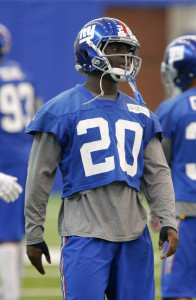
With so much talk around Pierre-Paul, it was easy to forget about the Giants’ other major free agent defensive lineman. Robert Ayers followed Amukamara to Florida when he inked a three-year, $19.5MM accord with the Buccaneers. The former first-round pick stepped it up in his walk year, recording nine sacks. Ayers always had a rep for good run-stopping ability, but his newfound pass-rushing acumen got him paid this spring. Ayers graded as one of the top pass rushers in the NFL in 2015, according to PFF’s metrics.
In March, the Giants opted to move on from offensive lineman Geoff Schwartz and linebacker Jon Beason. As it turns out, it would be the first of two times that Schwartz would be cut this offseason. Schwartz, 29, started 11 games for the Giants in 2015, but his season was cut short when he fractured a bone in his left leg in late November. By releasing him, the Giants avoided paying him $3.925MM annual salaries in 2016 and 2017, taking on a hit of about $1.917MM in dead money for 2016. Beason, meanwhile, decided to retire due to ongoing health issues.
Will Beatty‘s torn pectoral injury left the Giants with a big hole on the offensive line in 2015. In February of 2016, the Giants opted to cut him loose, leaving them with $5MM in dead money but also with $4.175 in cap space. The Giants ultimately did not want to commit that kind of money to a player that was still not healthy. Beatty only recently started auditioning for clubs and still finds himself without a job. The Jaguars, Cardinals, and Panthers are among the teams with interest.
It wouldn’t have cost much for the Giants to retain Cullen Jenkins, but they wanted to go younger on the D-Line. Last season, the defensive end started in 14 games for the Giants and appeared in all 16 contests. He tallied 26 tackles and 3.0 sacks. Now, he’ll look to terrorize the Giants as a member of the Redskins, provided that he makes the 53-man cut.
Hakeem Nicks was one of the best wide receivers to put on a Giants uniform in recent years. In November, the Giants welcomed the UNC product back after Victor Cruz was officially shut down for the season. Nicks, 27, spent the first five years of his career in New York with the Giants, enjoying the most productive stint of his career with the team. Posting consecutive seasons of 75+ receptions and 1,000+ receiving yards in 2010 and 2011, Nicks totaled 311 catches, 4,622 yards, and 27 TDs from 2009 to 2013. Of course, he’s no longer the same player. As of this writing, Nicks is without an NFL home for 2016.
 Rueben Randle was once viewed as a future star for the Giants. After years of waiting, the future never came for the powerful receiver. This offseason, Randle was courted by the rival Eagles and the Giants didn’t do much to keep him. The Giants were said to be concerned about Randle’s work ethic and they may have been proven right this week when the Eagles released him, leaving them with $500K+ in dead money.
Rueben Randle was once viewed as a future star for the Giants. After years of waiting, the future never came for the powerful receiver. This offseason, Randle was courted by the rival Eagles and the Giants didn’t do much to keep him. The Giants were said to be concerned about Randle’s work ethic and they may have been proven right this week when the Eagles released him, leaving them with $500K+ in dead money.
Draft picks:
Early on in draft season, scouting guru Dave-Te Thomas identified Eli Apple as the best cornerback in the draft not named Jalen Ramsey. If you want to get technical and call the versatile Ramsey a safety, then Apple stands as the top CB talent in the 2016 class. Truth be told, Apple was not the Giants’ top target at No. 10. Leading up to the draft, GM Jerry Reese was hoping to land either Georgia linebacker Leonard Floyd or Michigan State tackle Jack Conklin, but both prospects came off the board before it was their turn at the podium.
Earlier this offseason, Thomas told PFR that he sees Apple making both an immediate and long-term impact for the Giants:
The early first round surprise could be starting by the time the season opener rolls around, at least as the nickel corner. He’s likely to ease Dominique Rodgers-Cromartie off the roster after the season to take his place opposite high-priced Rams addition, Janoris Jenkins. The first thing you notice about this former Buckeye is his natural playmaking instincts. He understands how receivers are trying to attack coverage and he is a master at reading quarterbacks’ eyes when having to drop into zone coverage. He also does an excellent job of mid-pointing high-low routes.
Apple is an explosive, quick-twitch athlete with a sudden closing burst, especially when receivers catch the ball in front of him. He possesses that second gear needed to track the ball downfield and he’s fast enough to recover when gets caught out of position. Thanks to his fluid hips, he can make the smooth transition when forced to change directions quickly. When he stays under control and keeps his knees bent, is a good tackler in space.
Apple isn’t the only Giants rookie drawing rave reviews in camp. The hype train behind wide receiver Sterling Shepard is going full speed as many envision him doing serious damage out of the slot. Darian Thompson, meanwhile, is likely to start for the Giants at free safety.
Extensions and Restructures:
Other:
It’s easy to take the skeptical view of the Giants’ head coaching change. After the Giants limped to a 6-10 finish in 2015, it made sense for the Giants to explore the possibility of moving on from Tom Coughlin. However, some questioned the team’s choice to stay in-house and promote offensive coordinator Ben McAdoo to the lead role.
McAdoo, who was hired as the Giants’ offensive coordinator in 2014, has helped Eli Manning enjoy perhaps the most productive two-year stretch of his NFL career. His success with Manning was the driving factor behind his promotion and Manning personally endorsed McAdoo for the job. Although the club has posted a 6-10 record in consecutive seasons, Manning has thrived, averaging 4,423 yards and about 33 touchdowns per season over the last two years, to go along with a 92.9 rating. The Giants finished in the top eight in the NFL in terms of both yards per game (372.3) and points per game (26.3) in 2015.
Top 10 cap hits for 2016:
- Eli Manning, QB: $24,200,000
- Olivier Vernon, DE: $13,000,000
- Jason Pierre-Paul, DE: $9,400,000
- Dominique Rodgers-Cromartie, CB: $8,000,000
- Janoris Jenkins, CB: $8,000,000
- Damon Harrison, DT: $6,600,000
- Will Beatty, T: $5,000,000 (dead money)
- Shane Vereen, RB: $4,916,666
- Victor Cruz, WR: $4,400,000
- J.T. Thomas, LB: $4,000,000
After three consecutive losing seasons, is this the year that we see the Giants rebound? There was a lot to like about what the Giants did this offseason – they made clear upgrades at cornerback and on the defensive line. However, they still have question marks on the offensive line and all the quarterback whispering in the world won’t help Manning if he doesn’t have adequate time in the pocket. We fully expect the Giants to win more than 6 games this year, but we’re less-than-certain about their playoff hopes.
Information from Over the Cap, Spotrac, and Roster Resource was used in the creation of this post. Photos courtesy of USA Today Sports Images.
By Zachary Links |
at August 30, 2016 10:10 am
In 2015, a locker room fight between Geno Smith and a reserve linebacker changed the entire course of the Jets’ season. The skirmish left Smith with a broken jaw and left the door open for Ryan Fitzpatrick to show what he could do. Not only was Fitzpatrick a capable fill-in, he turned out to be one of the league’s better quarterbacks last season.
How could the Jets and the Harvard grad ever top that kind of offseason drama? Well, they gave it their best shot this spring and summer.
Notable signings:
- Muhammad Wilkerson, DE: Five years, $86MM. $36.75MM guaranteed. Had been assigned franchise tag.
- Ryan Fitzpatrick, QB: One year, $12MM. Fully guaranteed.
- Matt Forte, RB: Three years, $12MM. $9MM guaranteed. $2MM available annually via escalators.
- Bilal Powell, RB: Three years, $11.25MM. $6MM guaranteed. $2.25MM available via escalators.
- Steve McLendon, DT: Three years, $10.5MM. $4MM guaranteed. $1.5MM available via escalators.
- Jarvis Jenkins, DE: Two years, $6MM. $3MM guaranteed.
- Erin Henderson, LB: Two years, $4MM. $750K guaranteed. $1MM available via incentives.
- Kellen Davis, TE: One year, minimum salary benefit. $230K guaranteed.
- Khiry Robinson, RB: One year, $1.175MM. $80K guaranteed.
- Bruce Carter, LB: One year, minimum salary benefit. $80K guaranteed.
- Darryl Morris, CB: One year, $750K. $75K guaranteed.
- Jeremy Ross, WR: One year, minimum salary benefit. $50K guaranteed.
- Kenbrell Thompkins, WR: One year, $1.671MM. Signed original-round RFA tender.
- Zach Sudfeld, TE: One year, $600K.
- Antone Smith, RB: Contract terms unknown.
In the spring, the Jets tried to re-sign Fitzpatrick to a three-year deal in the $7MM/year range. That annual value was similar to the contracts signed by Robert Griffin III and Chase Daniel earlier this offseason. Of course, Fitzpatrick was significantly more productive in 2015 than those two have been in recent years. His camp argued that he was in line for about $14-15MM year, pointing out that Sam Bradford and Brock Osweiler received contracts in the neighborhood of $18MM annually, even though they also didn’t achieve what Fitzpatrick did last year. The only trouble is, no other team appeared to show serious interest in him. Even the Broncos – who were left without a QB after one retired and one bolted – didn’t seem very interested in Fitzpatrick. 
The standoff took a number of weird twists and turns. First, there was a report that Fitzpatrick would rather walk away from the sport altogether than pay on what he believed was an unsatisfactory contract. Then, there were rumblings that he would consider playing as a No. 2 quarterback elsewhere to spite the Jets. Both claims were likely floated out by Fitzpatrick’s reps, but neither threat had much behind it.
Eventually, the Jets and Fitzpatrick came back to the negotiating table and shook hands on a one-year, fully guaranteed pact worth $12MM. Even though Fitzpatrick turns 34 in November, he should have the opportunity to cash in a multi-year deal next offseason if he is able to reprise his ’15 performance. Many would say that Fitzpatrick won the stare down with the Jets, but both sides needed each other and it’s hard to fault Gang Green for caving.
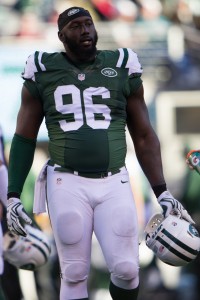 In all of the talk surrounding Fitzpatrick, defensive end Muhammad Wilkerson was almost an afterthought. Wilkerson, 27 in October, has established himself as one of the game’s best young defensive ends. Unlike talented teammate Sheldon Richardson, he has stayed out of trouble off the field while he dominates on the field. Still, the Jets showed very little interest in re-signing him this offseason, choosing instead to employ the franchise tag.
In all of the talk surrounding Fitzpatrick, defensive end Muhammad Wilkerson was almost an afterthought. Wilkerson, 27 in October, has established himself as one of the game’s best young defensive ends. Unlike talented teammate Sheldon Richardson, he has stayed out of trouble off the field while he dominates on the field. Still, the Jets showed very little interest in re-signing him this offseason, choosing instead to employ the franchise tag.
“Do I feel that they want me back? As of right now, no. I don’t feel like they want me,” Wilkerson said. “I’m a talented guy. Everybody knows that. I feel like they’re going to get the best they can out of me and just let me go. That’s how I feel. Do I like that feeling? No. I’m a New Jersey guy, born and raised and would love to raise my family here.”
Then, on the day of the franchise tag extension deadline, the Jets shocked the world when they announced that they had reached a five-year, $86MM deal with Wilkerson. So, what changed? It’s possible that the Jets realized late in the game that they needed to hammer out a long-term deal in order to improve their cap situation in 2016. Whatever the reason, Jets fans rejoiced when Wilkerson was locked up for years to come. $37MM of Wilkerson’s deal is fully guaranteed with $54MM coming to him over the next three years. That means that Wilkerson is getting paid major money, but the Jets can also cut bait with him prior to the 2018 season to get out of the other $17MM.
The Jets made a big splash in free agency when they signed running back Matt Forte. Numerous clubs were said to be interested in Forte after the 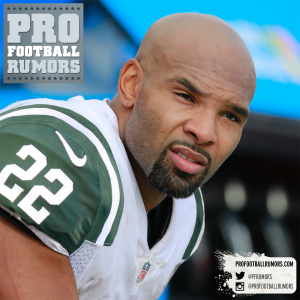 Bears informed him that he would not be re-signed after eight seasons in Chicago. Forte had a relatively down season in 2015, missing three games with injury and failing to top 1,000 yards rushing for the first time since 2011. But, he still managed almost 1,300 yards from scrimmage thanks to his receiving ability — he caught 44 passes out of the backfield for almost 400 yards. Some are skeptical about what Forte can do at his age (31 in December), but he has a lot more in the tank than LaDainian Tomlinson did when he joined up with the Jets as a free agent years ago.
Bears informed him that he would not be re-signed after eight seasons in Chicago. Forte had a relatively down season in 2015, missing three games with injury and failing to top 1,000 yards rushing for the first time since 2011. But, he still managed almost 1,300 yards from scrimmage thanks to his receiving ability — he caught 44 passes out of the backfield for almost 400 yards. Some are skeptical about what Forte can do at his age (31 in December), but he has a lot more in the tank than LaDainian Tomlinson did when he joined up with the Jets as a free agent years ago.
Besides, the Jets still have Bilal Powell to help run the ball and ease Forte’s workload. Powell averaged a career-high 4.5 yards per carry on 70 attempts last season and added a personal-best 47 receptions. The Jets did not want to let him linger on the free agent market and they wrapped him up on March 10th, keeping him away from interested clubs including the Cowboys, Ravens, Broncos, and rival Patriots.
Read more
Notable losses:
- Antonio Allen, S
- Stephen Bowen: Retired
- Randy Bullock, K
- Willie Colon, G
- Antonio Cromartie, CB: Released
- Jeff Cumberland, TE
- Demario Davis, LB
- Leger Douzable, DE
- D’Brickashaw Ferguson, T: Retired
- Damon Harrison, DT
- Chris Ivory, RB
- Jaiquawn Jarrett, S
- Jeremy Kerley, WR: Released
- Jamari Lattimore, LB
- Chris Owusu, WR
- Calvin Pace, LB
- Stevan Ridley, RB
- Zac Stacy, RB: Waived
- Darrin Walls, CB
While the Jets locked up Wilkerson for years to come, they watched defensive tackle Damon Harrison go elsewhere. Well, he’ll actually stay in the same building, just in different clothes. The Giants scooped up “Snacks” in March, giving him a five-year, $46.25MM deal. The Jets badly wanted to retain Harrison, but the bidding quickly got out of control with several teams interested in him. Harrison was ranked No. 8 on PFR’s Top 50 NFL Free Agents list for this past offseason and the Jets will have to find a way to stuff the run without Harrison in the middle.
Before the Jets signed Forte, they saw Chris Ivory ink a free agent deal with the Jaguars. Ivory, to no one’s surprise, had lots of suitors after him when the legal tampering period kicked off. But, to everyone’s surprise, he landed in Jacksonville. Last year, Ivory topped 1,000 yards rushing for the first time in his six-year career. The powerful back averaged 4.3 yards per carry, scored 7 touchdowns, and even helped out in the passing game, posting 30 receptions. However, if all goes according to plan in New York, he won’t necessarily be missed.
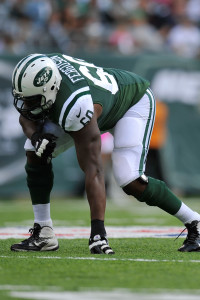 The Jets asked D’Brickashaw Ferguson recently to take a pay cut. Ferguson responded by making a decision that gave Gang Green plenty of cap room – he retired. The 32-year-old never missed a game during his ten-year career and he was reportedly healthy. Ultimately, Ferguson decided that he just wanted to do something other than play football for the first time in a long time. Ferguson had been slated to count for $14.107MM against the Jets’ cap in 2016, which was somewhat problematic. Ferguson’s decision to retire gave the Jets $9MM+ in cap savings, which they desperately needed.
The Jets asked D’Brickashaw Ferguson recently to take a pay cut. Ferguson responded by making a decision that gave Gang Green plenty of cap room – he retired. The 32-year-old never missed a game during his ten-year career and he was reportedly healthy. Ultimately, Ferguson decided that he just wanted to do something other than play football for the first time in a long time. Ferguson had been slated to count for $14.107MM against the Jets’ cap in 2016, which was somewhat problematic. Ferguson’s decision to retire gave the Jets $9MM+ in cap savings, which they desperately needed.
New Jersey native Bon Jovi rhetorically asks, “Who says you can’t go home?” Well, Antonio Cromartie did return to New Jersey to try and reprise some of his best seasons and the Jets even paired him up with old friend Darrelle Revis. Unfortunately, the reunion did not go as planned. In February, the Jets released Cro after he was ranked 86th out of 111 qualified cornerbacks by Pro Football Focus. Because Cromartie’s pact was essentially a pay-as-you-go deal, it allowed the Jets to get out of it this year without taking on any dead money. In his first year, Cromartie earned a $5MM base salary and a $2MM roster bonus. For 2016, his $8MM base salary was fully non-guaranteed, so New York created $8MM in cap savings by releasing him.
Trades:
- Acquired T Ryan Clady and a 2016 seventh-round pick (No. 235) from the Broncos in exchange for a 2016 fifth-round pick (No. 157).
- Acquired a 2016 fifth-round pick (No. 158) from the Redskins in exchange for a 2017 fourth-round pick.
To replace Ferguson, the Jets got creative and scanned the trade market. In April, the Jets shipped a fifth-round pick to the Broncos in exchange for Ryan Clady and a seventh-round choice. While Ferguson famously missed only a single offensive snap during his time with the Jets, Clady doesn’t have that same track record of durability. Injuries have marred the former first-round pick’s career, as Clady played in only two games during the 2013 season before suffering a Lisfranc injury, and missed all of the 2015 campaign after tearing his ACL during OTAs. Aside from those seasons, however, Clady has been a 16-game starter in every season of his career.
Clady re-worked his sizable contract to help facilitate the deal and it’s quite favorable for the Jets. Clady will have a one-year, $6MM deal ($3MM guaranteed) for 2016 which can max out at $7.5MM through incentives. That’s a very fair price if Clady can stay on the field. Then, the Jets will then hold a $10MM option — which can max out at $13MM — for 2017.
The Jets ranked No. 3 in pass protection per Football Outsiders’ metrics, but No. 26 in adjusted line yards. More specifically, Clady figures to be an improvement on Ferguson’s 2015 production, as Ferguson ranked as just the 60th-best offensive tackle in the league among 77 qualifiers, per Pro Football Focus.
Draft picks:
At No. 20 overall, the Jets landed the player who was hailed as “the best defensive playmaker in the 2016 draft” by PFR’s resident scouting guru Dave-Te Thomas. Some observers were down on the linebacker in 2015 with claims that he had regressed from how he played in 2014. However, Lee was quietly dealing with a lower leg injury that hampered him for much of the ’15 season. Later on in the year, when he got healthy again, Lee proved himself to be one of the nation’s top defensive talents. Lee’s rookie negotiations took quite a while with the first-round pick only signing in late July. However, that’s ancient history after Joey Bosa stole headlines in San Diego with his extended holdout.
The jury is still out on quarterback Christian Hackenberg and it may be a while before we can judge the second-round draft choice. The Jets are high on the Penn State product, but he will need lots of time to develop. Had the Jets moved up and selected someone like Carson Wentz, they might have been able to use the selection to apply additional pressure to Fitzpatrick. When the Jets took Hackenberg, it was widely understood that it had no bearing on their current QB situation. Now, it will be interesting to see how the Jets deal with their four quarterbacks in Fitzpatrick, Hackenberg, Petty, and Geno Smith. Common sense dictates that the team will have to shed either Petty or Smith, but some have speculated that the Jets could carry all four QBs on the roster. Petty has drawn solid reviews this offseason, so it may prove difficult to sneak him on the taxi squad.
Jenkins and Shell could both be important players for the Jets in 2016, Thomas tells PFR. For what it’s worth, he’s not a huge fan of Hackenberg.
Extensions and Restructures:
Other:
In May, the Jets made the no-brainer decision to exercise Sheldon Richardson’s 2017 option. Richardson, despite all of the off-the-field headaches, has been one of the Jets’ best defensive players since entering the NFL in 2013. Richardson is slated to earn $8MM+ in ’17 but, if he plays his cards right, he’ll have a much more lucrative deal signed before that comes into effect. The defensive lineman was issued a one-game suspension for violating the league’s personal-conduct policy, but he’ll be on the field for Gang Green in Week 2 to face the Bills and old friend Rex Ryan.
Just as the decision to exercise Richardson’s 2017 option was easy, so was the call to decline Dee Milliner‘s. The Jets have not ruled out keeping the cornerback beyond 2016, but he’ll have to show them something if he wants a future in green.
Top 10 cap hits for 2016:
- Darrelle Revis, CB: $17,000,000
- Muhammad Wilkerson, DE: $15,701,000
- Brandon Marshall, WR: $9,500,000
- Nick Mangold, C: $8,600,000
- Eric Decker, WR: $8,000,000
- Buster Skrine, CB: $7,750,000
- David Harris, LB: $7,500,000
- Breno Giacomini, T: $5,625,000
- Marcus Gilchrist, S: $5,625,000
- Ryan Clady, T: $5,500,000
The Jets dominated headlines in New York with their Fitzpatrick drama, but their offseason as a whole was somewhat uneventful, save for the Forte signing. After finishing 10-6 last year and falling short of the playoffs, the Jets are looking to take the next step forward in 2016. Under Todd Bowles, this defense-driven team can contend, but a lot will ride on a second dose of Fitzmagic.
Information from Over the Cap, Spotrac, and Roster Resource was used in the creation of this post. Photos courtesy of USA Today Sports Images.



 The Cardinals added two notable free agents to the linebacking group in Karlos Dansby and Jarvis Jones. Dansby returns to the Cardinals after spending the first six years of his career with them, plus the 2013 season. Dansby night not be a top 15 type like he was in 2013 and 2014, but he’s still quite productive even at his advanced age. The linebacker, 36 in November, had upwards of 100 tackles last year and finished out as Pro Football Focus’ 46th best linebacker out of 87 qualified players.
The Cardinals added two notable free agents to the linebacking group in Karlos Dansby and Jarvis Jones. Dansby returns to the Cardinals after spending the first six years of his career with them, plus the 2013 season. Dansby night not be a top 15 type like he was in 2013 and 2014, but he’s still quite productive even at his advanced age. The linebacker, 36 in November, had upwards of 100 tackles last year and finished out as Pro Football Focus’ 46th best linebacker out of 87 qualified players.
 Mark Barron, a former first-round pick, may be the most notable signing. After having revived his career in St. Louis last season, the 26-year-old inked a five-year contract to remain with the organization. Barron set career-highs in tackles (76) and forced fumbles (three) in 2015, and he’ll presumably remain as the team’s starting outside linebacker, providing some experience to a youthful unit.
Mark Barron, a former first-round pick, may be the most notable signing. After having revived his career in St. Louis last season, the 26-year-old inked a five-year contract to remain with the organization. Barron set career-highs in tackles (76) and forced fumbles (three) in 2015, and he’ll presumably remain as the team’s starting outside linebacker, providing some experience to a youthful unit. should be the veteran leader of the Rams’ offensive line, as the other four starters are all 24-years-old or younger.
should be the veteran leader of the Rams’ offensive line, as the other four starters are all 24-years-old or younger.
 The deal contains $36.5MM in full guarantees, but nearly 60% of that total comes in the form of guaranteed 2016 and 2017 base salaries. As such, the Redskins could conceivably exit the deal after two seasons without much dead money being left on the cap.
The deal contains $36.5MM in full guarantees, but nearly 60% of that total comes in the form of guaranteed 2016 and 2017 base salaries. As such, the Redskins could conceivably exit the deal after two seasons without much dead money being left on the cap. but he’ll get that opportunity now opposite DeAngelo Hall. Denver played a bunch of three-safety looks last year, so Bruton did see action on more than 40% of snaps in 2015. Meanwhile, Will Blackmon, Greg Toler, and Duke Ihenacho will all vie for rotational snaps in the defensive backfield while adding value on special teams.
but he’ll get that opportunity now opposite DeAngelo Hall. Denver played a bunch of three-safety looks last year, so Bruton did see action on more than 40% of snaps in 2015. Meanwhile, Will Blackmon, Greg Toler, and Duke Ihenacho will all vie for rotational snaps in the defensive backfield while adding value on special teams.
 Wide receiver Rishard Matthews was a pleasant surprise for Dolphins fans and fantasy owners alike in 2015. In 11 contests last season, Matthews totaled 662 yards and averaged 15.4 per reception as the Fins’ downfield complement to Jarvis Landry. Unfortunately, a season-ending injury later in the season ended his breakout campaign prematurely. That bad break also may have capped his free agent market somewhat. Ultimately, the Titans were able to sign Matthews to a three-year deal with a paltry $2.5MM guaranteed. After Dorial Green-Beckham was jettisoned to Philly, Matthews probably now stands as the team’s No. 1 wide receiver.
Wide receiver Rishard Matthews was a pleasant surprise for Dolphins fans and fantasy owners alike in 2015. In 11 contests last season, Matthews totaled 662 yards and averaged 15.4 per reception as the Fins’ downfield complement to Jarvis Landry. Unfortunately, a season-ending injury later in the season ended his breakout campaign prematurely. That bad break also may have capped his free agent market somewhat. Ultimately, the Titans were able to sign Matthews to a three-year deal with a paltry $2.5MM guaranteed. After Dorial Green-Beckham was jettisoned to Philly, Matthews probably now stands as the team’s No. 1 wide receiver.
 On the first day of free agency, the Giants pounced to sign Janoris Jenkins, a player widely considered to be the best cornerback in this year’s class. The Rams, choosing to put their funds elsewhere and their faith in Trumaine Johnson, only offered Jenkins a a five-year offer worth about $45MM. Jenkins wisely declined and entered the open market, where he got a whopping $62.5MM over five years with nearly $29MM guaranteed. In Jenkins, the Giants got a top cornerback who doesn’t turn 28 until October. Now, the Giants will have Jenkins and Dominique Rodgers-Cromartie in the secondary (plus a promising first-round choice – more on that later) and that will force opposing quarterbacks to think twice before they throw.
On the first day of free agency, the Giants pounced to sign Janoris Jenkins, a player widely considered to be the best cornerback in this year’s class. The Rams, choosing to put their funds elsewhere and their faith in Trumaine Johnson, only offered Jenkins a a five-year offer worth about $45MM. Jenkins wisely declined and entered the open market, where he got a whopping $62.5MM over five years with nearly $29MM guaranteed. In Jenkins, the Giants got a top cornerback who doesn’t turn 28 until October. Now, the Giants will have Jenkins and Dominique Rodgers-Cromartie in the secondary (plus a promising first-round choice – more on that later) and that will force opposing quarterbacks to think twice before they throw.
 In all of the talk surrounding Fitzpatrick, defensive end Muhammad Wilkerson was almost an afterthought. Wilkerson, 27 in October, has established himself as one of the game’s best young defensive ends. Unlike talented teammate Sheldon Richardson, he has stayed out of trouble off the field while he dominates on the field. Still, the Jets showed very little interest in re-signing him this offseason, choosing instead to employ the franchise tag.
In all of the talk surrounding Fitzpatrick, defensive end Muhammad Wilkerson was almost an afterthought. Wilkerson, 27 in October, has established himself as one of the game’s best young defensive ends. Unlike talented teammate Sheldon Richardson, he has stayed out of trouble off the field while he dominates on the field. Still, the Jets showed very little interest in re-signing him this offseason, choosing instead to employ the franchise tag. Bears informed him that he would not be re-signed after eight seasons in Chicago. Forte had a relatively down season in 2015, missing three games with injury and failing to top 1,000 yards rushing for the first time since 2011. But, he still managed almost 1,300 yards from scrimmage thanks to his receiving ability — he caught 44 passes out of the backfield for almost 400 yards. Some are skeptical about what Forte can do at his age (31 in December), but he has a lot more in the tank than LaDainian Tomlinson did when he joined up with the Jets as a free agent years ago.
Bears informed him that he would not be re-signed after eight seasons in Chicago. Forte had a relatively down season in 2015, missing three games with injury and failing to top 1,000 yards rushing for the first time since 2011. But, he still managed almost 1,300 yards from scrimmage thanks to his receiving ability — he caught 44 passes out of the backfield for almost 400 yards. Some are skeptical about what Forte can do at his age (31 in December), but he has a lot more in the tank than LaDainian Tomlinson did when he joined up with the Jets as a free agent years ago.




























